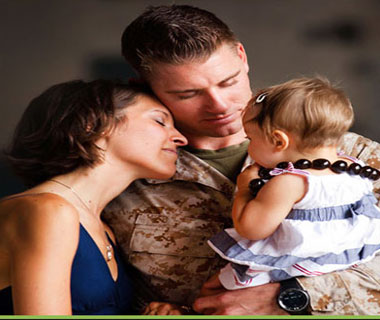Bret Stout is Enhancing Fort Worth – One Business at a Time.

Home I Experience I Portfolio I Capabilities I Clients I Contact
Badass Logo Designs I Website Design Fort Worth I Brand Strategy Fort Worth I Mobile Website Design Fort Worth
Logo Design Fort Worth I Vector Logos Fort Worth I Google Search Fort Worth I Search Engine Optimization Fort Worth
The Amazing Untold History of Fort Worth I Find Out More About Bret Stout
Check Out All of Bret Stout's Fort Worth Photo-Composites I Fort Worth Links I Sitemap
STORYTIME

Compiled and Written by Bret Stout

This is the amazing untold story of Fort Worth where we connect all the dots on Fort Worth in a way you've never seen before.
The dominating historical factor turns out to be the military - and you may not realize just how much the military and Fort Worth have in common. In fact, before it was ever a city, Fort Worth was a military fort named after US Army General William Jenkins Worth - who served in the War of 1812, Second Seminole War, and was second-in-command in the Mexican-American War.
Grab a cup of coffee and get comfortable.
We are now going to run through 168 years of Fort Worth's history. The content may be lengthy, but very exciting - and as you will discover, Fort Worth may just be the most colorful and interesting of ANY city in the United States. You will also discover how every other part of Fort Worth's rich history, from stagecoaches and railroad, from Chisholm Trail and the Stockyards, from TCU to Lockheed Martin, and little-known places and events like Hell's Half Acre to Panther City, are all connected together by Fort Worth's rich military history. After reading, you will know more about Fort Worth than anyone. And the best part? You will have a newfound appreciation for this amazing city we call home.
LET'S GET STARTED
Yes, before Fort Worth was a city it was a highly strategic military fort. The drawing on the left below is the very first-known depiction of the original fort site in 1849 along the Trinity River - same location where the Tarrant County Court House sits today. The middle drawing is the same location in 1885 (36 years later), and the drawing on the right is Fort Worth today, same location:

As for a time-frame point of reference, the Texas Revolution and the battle for the Alamo took place in 1836, 13 years BEFORE Fort Worth (Camp Worth) was established. - and the Mexican-American War was from 1846 to 1848, one year BEFORE. 1849 was also the same year as the California Gold Rush - hence the name "The 49ers". The Republic of Texas was annexed to the United States of America in 1845 and would become the 28th U.S. state in 1850, one year AFTER Fort Worth (Camp Worth) was established.
FORT WORTH'S ORIGIN WAS THE MILITARY
The year was 1849 and after serving in the Mexican-American War, General William J. Worth proposed building 10 forts to mark and protect the west Texas frontier, situated from Eagle Pass (on the border of Mexico between El Paso and Brownsville) to the confluence of the West Fork and Clear Fork of the Trinity River. The military fort to be established in present-day Fort Worth would be the northern most fort site of the 10 forts General Worth would propose. Only eight of the 10 proposed forts were ever completed - including Fort Worth, Fort Graham, Fort Gates, Fort Croghan, Fort Martin Scott, Fort Lincoln, Fort Inge, and Fort Duncan.

If you look at the terrain of Texas in the map below, you'll see why General Worth chose this line. This is where the terrain of Texas becomes more elevated and would serve as a distinct line of defense against the Indians. Fort Worth is also known as "Where the West Begins". Will Rogers once said, “Fort Worth is where the West begins and Dallas is where the East peters out.”

General Worth had instructed young Brevet Major Ripley A. Arnold and F Company of 2nd Dragoons (also known as the 2nd Cavalry Regiment) to establish the northern most military post at the site of the confluence of the West Fork and Clear Fork of the Trinity River (the current location of the Tarrant County Court House).

In the spring of 1849, Fort Graham on the Brazos River (where Whitney, Texas is today, just west of Hillsboro) was the most northern fort of General Worth's proposed defensive line. Fort Graham recently set up by Major Ripley Arnold - and this fort location left a 130-mile gap up to the Red River (Oklahoma border) which caused a "blind spot" in the state’s defenses. When General Worth died in May of 1849, General William S. Harney took command and ordered Major Ripley Arnold up north to the Trinity River to set up the final fort.
Major Ripley Arnold took a small party of 2nd Dragoons and proceeded to Johnson’s Station (present-day Arlington, Texas and just south of Bird's Fort established in 1841) where he hooked up with Colonel Middleton T. Johnson and four other cilivians. They then rode west to a spot up on the hill above the confluence of Clear Fork and West Fork on the Trinity River. There, at the end of May, they planted Old Glory on the future site of Fort Worth. Major Ripley then returned to Fort Graham, and a week later, he was back with his entire command, the 42 men of Company F, 2nd Dragoons, where the men began building the fort. By the time the fort was completed, the U.S. War Department officially granted the name "Fort Worth" in honor of General WIlliam J. Worth's distinguished military service.

Major Ripley A. Arnold would be known as the "Founder of Fort Worth"" because he actually led the building of the fort in what is now present-day Fort Worth. Note: historical plaques at current day Tarrant County Courthouse refers to this original fort as "Camp Worth". It was never referred to as "Camp Worth" - but the plaque would be confusing to refer to it as "Fort Worth" because this name has taken on a whole new meaning. So referring to it as "Camp Worth" makes the story easier to understand for the reader. Ripley A. Arnold was appointed to the United States Military at West Point in 1834 and was assigned to duty as a second lieutenant of the First Dragoons in 1838 (1st Calvary). He was promoted to major in 1846 for his role in the battles of Palo Alto and Resaca de la Palma.
Major Arnold served under General Worth through the Battle of Monterrey. He was then transferred to the army of General Winfield Scott and took part in the Battle of Molino del Rey and the capture of Mexico City in 1847. He was given command of F Company of the Second Dragoons after the Mexican War and ordered to northern Texas to establish a military post in the area General Worth had instructed at the Trinity River at Clear Fork and West Fork.

The year was 1849 and the President of the United States at the time, President James Polk, was at the end of his term and was succeeded in March 1849 by President Zachary Taylor, the 12th President. Most noteworthy is the fact that General Worth was second-in-command to General Taylor during the Mexican-American War and he was regularly in attendance at White House receptions. It has been said that General Worth was so highly respected that if he had not died in 1849, he would have likely succeeded President Taylor to become the President of the United States.

MOST IMPORTANT GENERAL YOU'VE NEVER HEARD OF

William Jenkins Worth was born in 1794 in Hudson, New York. Worth served in the War of 1812 and was commissioned as a first lieutenant in March 1813 serving as an aide to Brigadier General Winfield Scott. He distinguished himself at the battles of Chippewa and Lundy's Lane during the Niagara Campaign. In the latter battle, he was seriously wounded by grapeshot in the thigh and was not expected to survive. After a year's confinement he emerged with the breveted rank of Major. After the war he was Commandant of Cadets at West Point U.S. Military Academy.

Major Worth would rise to the rank of Colonel in 1838 when put in command of the newly-created Eighth Infantry Regiment. He led the battle in the Second Seminole War in Florida and was promoted to brigadier general in 1842. He convinced Secretary of War John C. Spencer to allow the remaining Indians in the territory to confine themselves to the region south of Peace Creek and declared an official end to the war in August 1842.

General Worth then served as second-in-command to General Taylor in Texas and he negotiated the surrender of the Mexican city of Matamoros. General Worth next commanded the 2nd Regular Division and the Texas Rangers at the Battle of Monterrey in September 1846.

In 1847, General Worth was transferred to Winfield Scott's Army and placed in command of the 1st Division. Note: General Winfield Scott was a Presidential Nominee in 1852, but lost to Franklin Pierce. Word has it that the term "Great Scott!" came from the soldiers under his command. There are even U.S. postage stamps with General Scott's depiction.
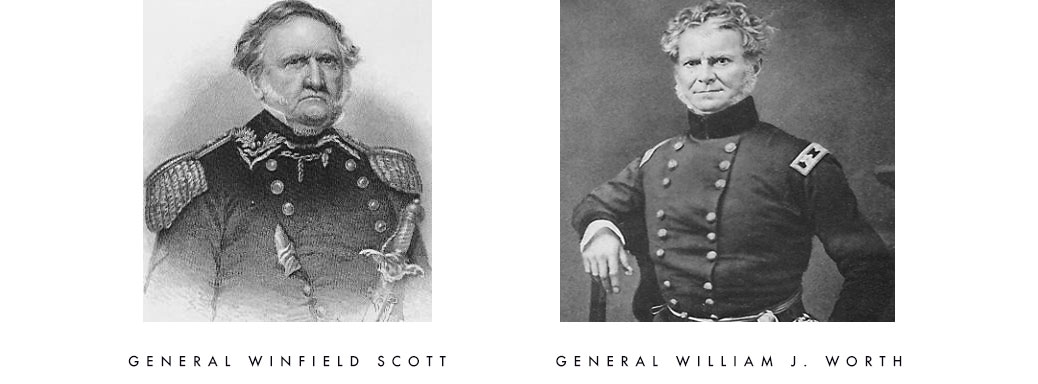
During the amphibious landings at Veracruz, General Worth led his troops by example - jumping from his boat into shoulder deep water and waded ashore to become the very first American soldier to make an amphibious landing on foreign soil.

General Worth then took part in the Siege of Veracruz and engaged in battles of Cerro Gordo, Contreras, and Churubusco. In Mexico City, General Worth seized the Mexican works at the Molino del Rey. He next led his division against the San Cosme at Mexico City. When U.S. forces entered Mexico City, General Worth personally climbed to the roof of the National Palace and took down the Mexican flag replacing it with the Stars and Stripes.

For his service at the Battle of Chapultepec, the United States Congress awarded General Worth with a Sword of Honor. It would be his third Ceremonial Sword of Honor - the equivalent of three combat medals in the days before it became customary to award medals. In 1849, and as Commander of the Department of Texas, General Worth headed up to from south to north Texas and selected the locations for military camps. The northern most fort would be next to the Trinity River, which is known today as Fort Worth, Texas. General Worth fought many great battles, he set the standards at West Point, and he personally selected this area of Texas to become our Fort Worth. Yes, General William J. Worth is the-most-important-general-you've-never-heard-of and the namesake for our great city.
SO WHY IS IT CALLED TARRANT COUNTY?
Our county is called Tarrant County after Brigadier General Edward H. Tarrant of a northeast Texas militia unit called the Fourth Brigade. Tarrant fought in the War of 1812 at age of 19, and took part in the Battle of New Orleans (1814-1815). Tarrant was promoted to the rank of Colonel in the Tennessee State Militia and was also a Sheriff of Henry County, Tennessee. Colonel Tarrant moved to Texas in 1835 and established a ranch in Red River County (between Paris, Texas and Texarkana, Texas). In September 1837, Colonel Tarrant was elected to represent Red River County in the House of Representatives of the Second Texan Congress, but after a few months he resigned to serve the Texas Republic in directing Texas Ranger activities against the Indians in 1938.
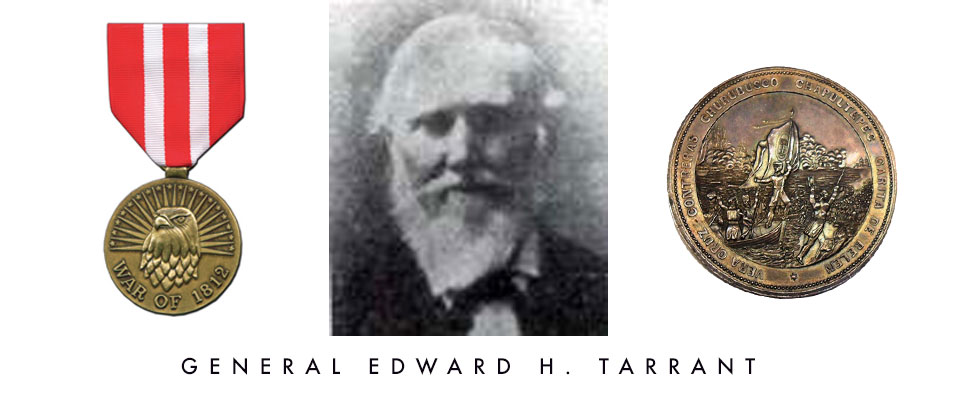
Edward H. Tarrant was only 15 years old when he fought in the War of 1812 and served under General Andrew Jackson in the Battle of New Orleans (young Tarrant served in 1815). In May 1841, General Tarrant organized a company of approximately 70 volunteers from the Red River counties and Tarrant's Indian-fighting career culminated in the Battle of Village Creek, east of present-day Fort Worth (from Arlington, Texas to Cross Timber, Texas). The Republic of Texas militia had scouting detachments which were commanded by Captain John B. Denton, Captain Henry B. Stout (a relative of Bret Stout?), and Captain James G. Bourland. General Tarrant and George Whitfield Terrell (former Secretary of State of the Republic of Texas and Indian Commissioner) negotiated treaties with many of the Texas and Oklahoma Indian tribes with the Treaty of Bird's Fort in 1843 (present-day Arlington, Texas). General Tarrant served two terms in the Texas House of Representatives between 1849 and 1853 and died in 1858 just 10 miles from Weatherford, Texas in Parker County. General Tarrant spent a lot of time in Fort Worth and Fort Belknap (northwest of Possum Kingdom Lake near Graham, Texas). The name Belknap may sound familiar because it's a main street in downtown Fort Worth. Fort Belknap was established in November 1851 by Brigadier General William G. Belknap to protect the Texas frontier against raids by the Kiowa and Comanche Indians. General Tarrant's final resting place is at Pioneer Rest Cemetery located in Fort Worth's long-lost, but historical neighborhood of Rock Island and Samuels Avenue located just northeast of downtown (between the Trinity River and Interstae 35W). His tombstone reads, "General Edward H. Tarrant. This stone marks his resting place. Tarrant County is his monument".
FORT WORTH MILITARY STREET NAMING
Most people never really think about the origins of the names of our Fort Worth streets, but most were named in honor of military commanders who served in Fort Worth and Texas. In addition, namesakes also include significant leaders in law enforcement, politics, and industries specific to Fort Worth's history.
Belknap Street was named after Brigadier General William Goldsworth Belknap who fought in the War of 1812, Second Seminole Wars in Florida, many of the major battles of the Mexican-American War, and fought against Kiowa and Comanche Indians in Texas. In addition, the military base Fort Belknap, west of Fort Worth, was also named in his honor.

Camp Bowie Blvd was named after James "Jim" Bowie, who played a prominent role in the Texas Revolution and was famous for his knife skills (hence the name "Bowie Knife"). Bowie died at the Battle of the Alamo.

Daggett Avenue was named after Captain Ephraim Merrill Daggett, served in the Mexican-American War and served on the Texas Ranger. Daggett was one of the very to set up a homestead in Fort Worth and was once called "The Grandfather of Fort Worth". Captain Daggett came to the Fort Worth military fort with his two brothers in 1854 and he stayed until his death. His brother Charles Daggett built a home on what is now Mount Olivet Cemetery. His brother Henry Daggett had to find a location at least one mile from the main fort pursuant to Federal Law to open a log cabin mercantile store. The location he selected which would be the Rock Island Samuels Avenue area directly northeast of the fort. Captain Daggett set up his plantation on the southern end of what is now downtown, and although a known slave owner, he was reportedly a very kind one - as it is documented that his former slaves were very fond of him. Captain Daggett spent a lot his time promoting Fort Worth as a city and donated his plantation land for the Texas and Pacific Railroad tracks and depot, the very first railroad for Fort Worth.

Foch Street was named after General Ferdinand Foch, a French military commander who was the Supreme Allied Commander of the allied forces during WWI.

Hemphill Street was named after John Hemphill, Senator and the first Chief Justice of the Texas Supreme Court under Sam Houston. He was nicknamed "John Marshall of Texas" for the role he played in the development of Texas law, laying the foundation of Texas' judicial system. He was elected to represent Texas as a United States Senator after Sam Houston was forced to step down when Senator Houston would not support the right of states to secede from the United States.

Houston Street was named after General Sam Houston who was a US Army General and a leader in the Texas Revolution. Houston served in the War of 1812 and was wounded at Horseshoe Bend in the Creek War in 1814. He would later serve as the President of the Republic of Texas and his victory at the Battle of San Jacinto in 1836 secured the independence of Texas from Mexico. He would be a co-signer of the Texas Declaration of Independence in 1836 and would later become the Governor of Texas in 1859. When Texas secedded from the Union in 1861 with the outbreak of the Civil War, General Houston refused to swear loyalty to the Confederacy and was removed from office. Former Governor Houston also refused an offer with the Union Army to put down the Confederate rebellion. Instead he retired to Huntsville, Texas and died in July 1863.

Hulen Street was named after Lieutenant General John Augustus Hulen, recipient of the Silver Star (third-highest U.S. military medal for valor in combat), Distinguished Service Medal (awarded for exceptional meritorious service), and the Croix de Guerre (presented by France and awarded for distinguished acts of heroism).

Born in Centralia, Missouri, John Hulen's family moved to Gainsville, Texas when he was two years old. General John A. Hulen was one solder who saw the US Army switch from muzzle-lkeoading muskets to Garands and bazookas, and from horse cavalry to mechanized cavalry. Hulen served with Third Texas Volunteer Infanty in 1887, commanded as captain over Troop D until 1889 leading the Thirty-Third U.S. Volunteer Infantry fighting in the jungles of northern Luzon (1899-1901). It was in this battle he was awarded the Silver Star. As a brevet lieutenant colonel he served in the Spanish-American War. Upon his return to Texas, Governor Samuel W. T. Lanham promoted him to brigadier general and appointed him adjutant general (1902-1907). General Hulen was recalled to service in 1916 as Commander of the Sixth Separate Brigade and helped reorganize the State Militia into the 36th Infantry Division at Camp Bowie. He then commanded the 72nd Brigade (1917-1919) in World War I and was awarded the Distinguished Service Medal and the Croix de Guerre (twice) during the Meuse-Argonne offensive. In 1920 he was promoted to major general in the Texas National Guard and in 1922 to commander of the 36th Division until 1935. In 1941 President Franklin D. Roosevelt appointed General Hulen regional salvage manager of the War Production Board, a position he held throughout World War II. Camp Hulen was named in his honor and was located on Matagorda Bay, Texas (in the city of Palacios southwest of Galveston, Texas). At General Hulen's retirement ceremony, Governor James Allred promoted him to lieutenant general, the militia's highest rank. Hulen served under General Charles MacArthur and his son, General Douglas MacArthur and was a trusted general under General John J. Pershing.
Jennings Avenue was named after Thomas Jefferson Jennings who was Attorney General of Texas from 1852 to 1856.

Lancaster Street was named for J.L. Lancaster, the President of the Texas and Pacific Railway Company and served on the board of TCU.

Lubbock Avenue was named after Francis Richard Lubbock, Governor of Texas from 1861 to 1863, but resigned to join the Confederate Army.

Jacksboro Highway was named after William Houston Jack, a Veteran of the Texas Revolution and Republic of Texas Congressman and Secretary of State.

FORT WORTH + CIVIL WAR
The Civil War would take place from 1861 to 1865 - over a decade after Fort Worth was founded in 1849. The U.S. State of Texas declared its secession from the United States of America on 1 February 1861, and joined the Confederate States on 2 March 1861, after replacing Texas Governor Sam Houston when he refused to take an oath of allegiance to the Confederacy. As with those of other States, the Declaration was not recognized by the United States government in Washington. Some Texan military units fought in the Civil War east of the Mississippi River, but Fort Worth was most useful in providing soldiers, horses, and supplies for Confederate forces.

A little known fact is that Fort Worth is home to the largest Civil War museum west of the Mississippi River featuring weapons, uniforms, artifacts and civilian clothing from the Civil War. The Texas Civil War Museum has 75-seat theater shows videos about Texas's involvement in the Civil War.
FORT WORTH + CHISHOLM TRAIL
Because of Chisholm Trail's direct connection from Fort Worth to midwestern markets, the cattle market, combined with military and transportation, played a key role in Fort Worth’s unprecedented growth. Interestingly, the very first cattle drive on the Chisholm Trail ran from Dewitt County, Texas (south of San Antonio, Texas) to St. Joseph, Missouri (north of Kansas City, Missouri). Note: St. Joseph, Missouri was the birthplace of both of Bret Stout's parents, home of Jesse James and the Pony Express - and both his grandfathers, one American Indian and one native German, made their living in the cattle industry at the St. Joseph Stockyards - the largest stock yards in the midwest for many years.
Click here to read more


History has it that Indian Scout Jesse Chisholm marked the 'Upper Trail' and was fluent in fourteen different Indian dialects. Because of his superb communication skills, Jesse Chisholm was highly successful in trading goods with the various tribes in Indian Territory. But after marking the trail, Jesse Chisholm retired. Enter Crockett Cardwell, owner of cattle bedground in Texas. Cardwell had gathered the herd for the first drive from Dewitt County all the way to St. Joseph, Missouri with trail boss Thornton Chisholm, a native a DeWitt County. History is not clear whether these two Chisholms were related - and different counts state the origin of Chisholm Trail by one or the other parties. It is a fact that Jesse Chisholm, a fur trader, marked the first trail, but it was Thornton Chisholm who started driving cattle on it.

There is also debate whether the 'official' Chisholm Trail actually went south of the Red River - Oklahoma historians don't believe Texas is part of the Chisholm Trail. Some say the trail in Texas should be called "The Eastern Trail" and have suggested it should be called "The Eastern-Chisholm Trail" - but the Eastern Trail ran east to Shreveport. But the fact remains that Thornton Chisholm is the first one who drove cattle all the way through Texas to the Red River, Oklahoma, Kansas, and Missouri, so others say it should be called the "Thornton Chisholm Trail" in Texas and the "Jesse Chisholm Trail" north of the Red River. Remember, history states that Jesse Chisholm marked the 'Upper Trail' - which could reference North of the Red River into Indian Country of Oklahoma. The debate will likely continue.
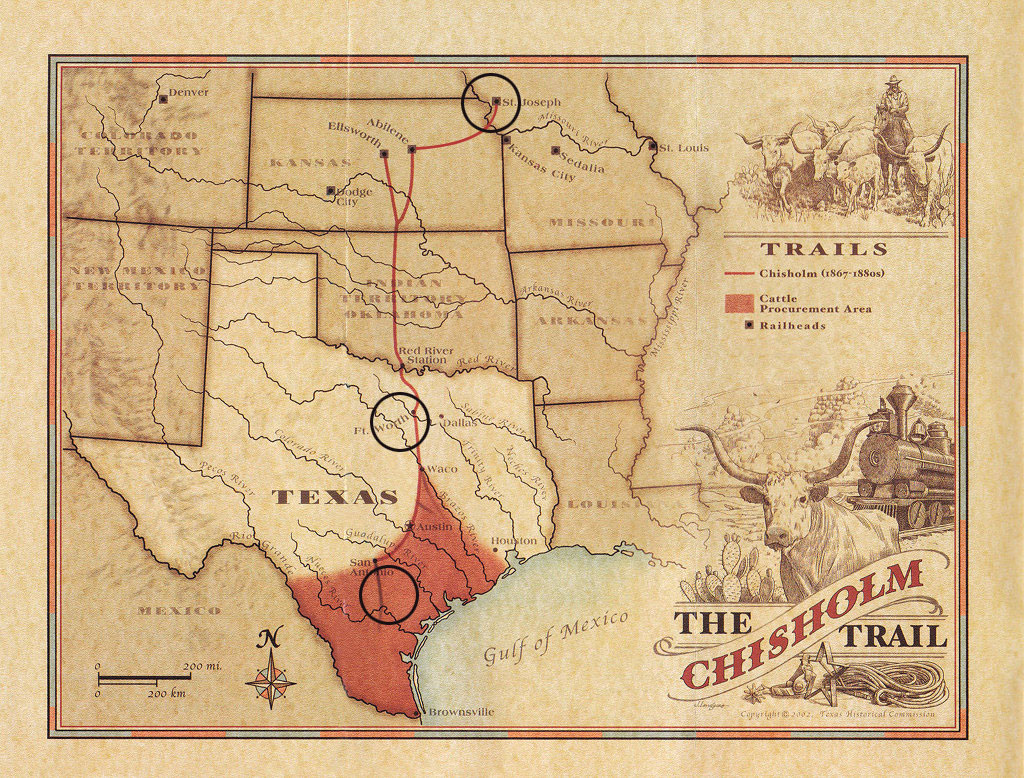
Thornton Chisholm and Crockett Cardwell's cattle drive up the Chisholm Trail moved north past Gonzales, San Marcos, Austin, Round Rock, Georgetown, Gatesville, Glen Rose, Fort Worth, and Red River Station, and then into Indian territory of Oklahoma, Kansas, and all the way to Missouri. The 30 men of this 1866 drive to St. Joseph, Missouri (and back) were gone seven months and 10 days.

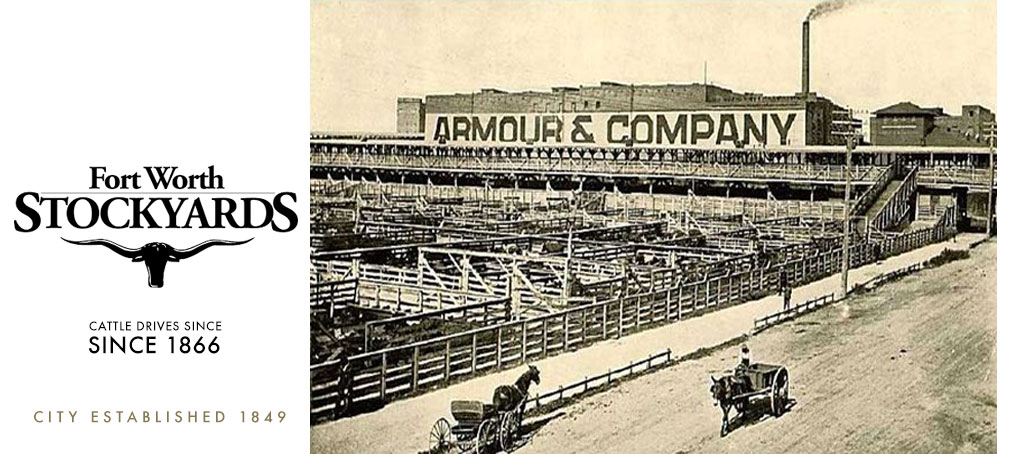

Texas Confederate soldiers returning home to Fort Worth from the Civil War found that in their absence, the herds of longhorn cattle they were raising before the war had doubled in size. In fact, their cattle was so plentiful, they had less value in Texas - but the industrial cities of the North were booming with immigrant labor and hungry mouths to feed. So these military Veterans began the great cattle drives north to Oklahoma, Kansas, Missouri, and Wyoming. There they met the new railroad lines that could carry the meat to the east and west coasts.

Herds of cattle that originated throughout the Chisholm corridor and South Texas poured directly to Fort Worth = or through Fort Worth on their way up the trail. This made the Fort Worth Stockyards the largest (and most famous) in the country. The Fort Worth Stockyards National Register Historic District is home to the Livestock Exchange Building, the Stockyards Coliseum, and the Stockyards Station. And you can still experience the cattle drives through Fort Worth - cowboys on horseback drive Longhorn cattle (twice daily) along west to east Exchange Avenue, the main street in the Fort Worth Stockyards (11:30am and 4:00pm). Click here to find out more
BUT YET ANOTHER CHISUM
To make the famous trail's origin even more confusing and controversial is another Chisum (but spelled differently). History shows that "Chisholm Trail" was known previously by others names, and the State of Texas had many trails, including The Cattle Trail, The Great Western Trail, The Goodnight-Loving Trail, The Shawnee (or Texas) Trail, The Sedalia Trail, The Lonesome Dove Trail, The Great Eastern Trail, The Great Texas Cattle Trail, The Kansas Trail, The McCoy's Trail, and The Abiline Trail. Interestingly, The the famous John Simpson Chisum (yes, spelled differently - but pronounced exactly the same as Chisholm) and his trail stretched from Shreveport to Fort Sumner, New Mexico - going straight through Fort Worth. John Chisum had over 100,000 head of cattle and was known as "The Toughest Man West of the Pecos" (Pecos, Texas is in west Texas) and was a wealthy cattle barron who was one of the first to drive cattle from Texas to the New Mexico Territory in 1854, 12 years before Thornton Chisholm ran his cattle drive from DeWitt County north through Fort Worth and north to St. Joseph, Missouri. John Chisum, the wealthy Texas cattle barron, supported the military, and along with Charles Goodnight (former "Colonel Goodnight" and one of the most well-known Texas cattle ranchers) drove herds through Fort Worth and east to the Confederates at Fort Pike and Fort Macomb in Shreveport, Louisiana during the Civil War, and drove cattle through Fort Worth and west through Abiline and to the U.S. Army at Fort Sumner in New Mexico.

John Chisum became even more well-known for his actions in the Lincoln County War (in New Mexico) where he fought on the same side with Billy the Kid. After the war, Billy the Kid went to see Chisum believing that the cattle baron owed him $500, but Chisum refused to pay. In retaliation, Billy, along with his gang began to steal Chisum’s cattle. In 1880, Chisum supported the election of Pat Garrett who believed he could stop the cattle rustling problems. It would be Garrett who tracked down Billy the Kid and killed him on 14 July 1881. John Chisum would be portrayed in several television shows and movies, including 1970's "Chisum" (John Wayne as Chisum), 1990's "Young Guns" (James Coburn as Chisum), 1953's "San Antone", 1960 episode of Bronco "Death of an Outlaw", 1965 episode of Death Valley Days "Paid in Full", 1973's "Pat Garrett & Billy the Kid", and 2011's UK film "Billy the Kid & the Lincoln County War".
FORT WORTH + DEPRESSION + PANTHER CITY
In 1875, shortly after the Civil War, railroad over-expansion and loan defaults triggered a nationwide depression - and combine that a very harsh winter, it dealt a severe blow to the cattle industry and city of Fort Worth. This caused a major drop in Fort Worth's population - some say down to 175 people. Making matters even less hopeful, the Texas and Pacific Railway Company had stopped laying tracks 30 miles outside of Fort Worth. Robert E. Cowart, a Dallas lawyer who had just recently visited Fort Worth for a meeting, wrote the editor of the Dallas newspaper that Fort Worth was so quiet and deserted ("torid"), he had seen a PANTHER asleep on the steps of the courthouse.

Because of this intended insult, the remaining citizens of Fort Worth, along with the military servicemen still camped here, took up the abandoned tools and materials of the railroadmen and completed the tracks themselves. The whole city got behind the effort and met the deadline set by Texas legislature. A new spirit arose in Fort Worth as PANTHER MADNESS became the rage. The city's future was secure, and the nickname 'Panther City' stuck.
Although an intended insult, the nickname Panther City was embraced by residents as Fort Worth recovered the next year from the depression. That same spirit of our pioneering and perseverance lives on in the people of Fort Worth today and the Panther became the symbol of that amazing spirit.

The fire fighter volunteers, organized by Buckley B. Paddock, adopted a Panther masthead for their fire company No. 1, named along with a live Panther mascot. For nearly 150 years the "Panther" and "Panther City" have been lovingly embraced by Fort Worth - even the Fort Worth Police Department has used the Panther in their badge design since 1912. The Fort Worth Police Historical Association also uses the PANTHER name as an acronym P.A.N.T.H.E.R. - meaing Professional Accountable Noble Truthful Honorable Ethical and Respectful.

A sorta smack-in-the-face to Dallas, the Panther name was fully adopted by the citizens of Fort Worth and has since been used in the naming of a number of Fort Worth venues and events - like the famous Cowtown Jamboree's "Panther Hall". Click here to find out more. Famous singers performed at the famous Panther Hall, like Willie Nelson, Conway Twitty, Waylon Jennings, Bob Wills, and Jerry Lee Lewis.
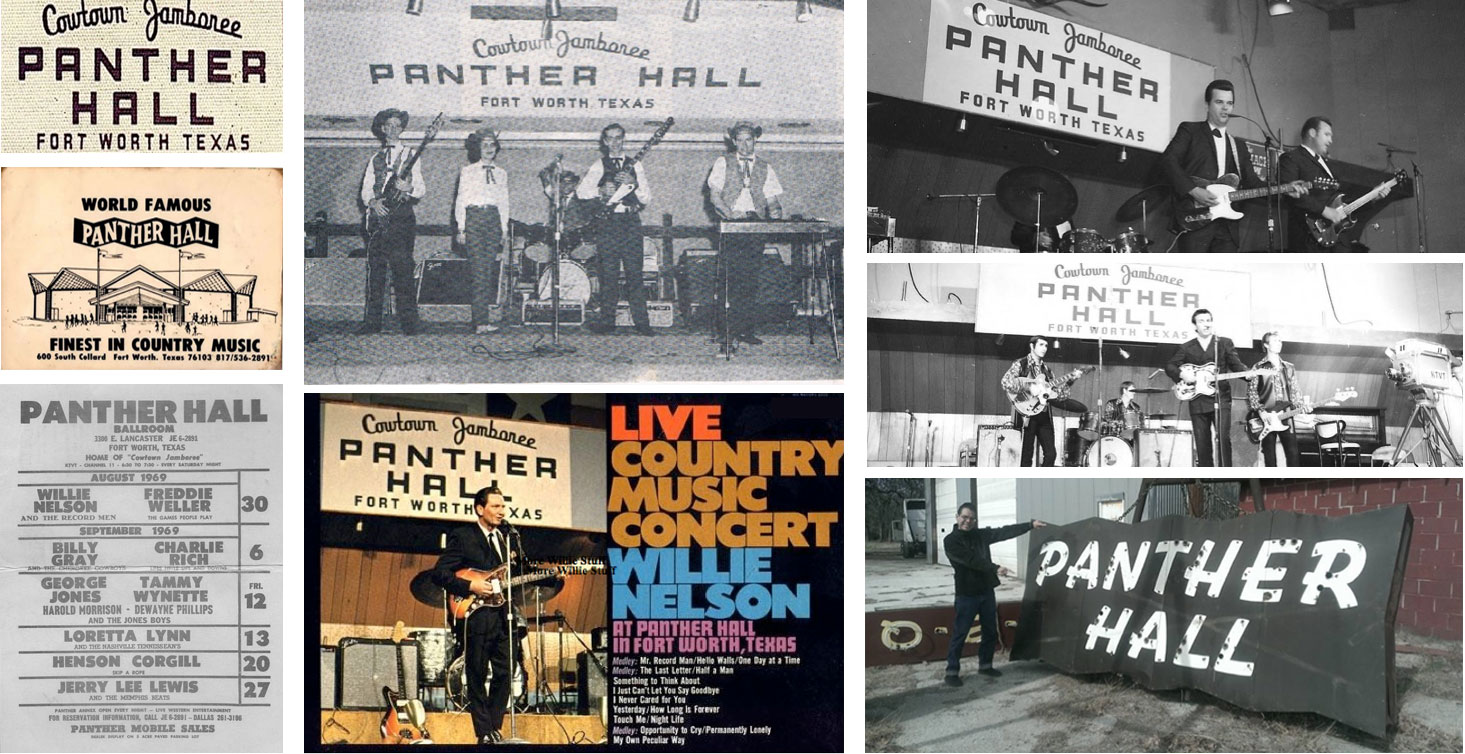
The Panther reference has been used non-stop since 1876.

The Panther reference has not gone away. If you look for it, you will see the Panther proudly displayed on Fort Worth public buildings within the architecture. And now that you know about the Panther, you will now see it everywhere - Fort Worth school mascots, Fort Worth baseball teams, and even areas of the city like Panther Island.
The Panther and the Panther name is an enduring Fort Worth icon used in names of many businesses, events, and areas of Fort Worth.

Remember, it was the military servicemen who helped the citizens of Fort Worth to complete the final 30 miles of railroad in 1876. Later on in 1917 at Camp Bowie, the 36th Infantry Division's Texas Division would adopt the Panther name and was known as the Texas Panther Division. The Panther Division was a US Army infantry division that was a part of the Texas Army National Guard during WWI. The Panther Division was activated for service for WWII on 25 November 1940, and deployed to the European Theater of Operations in April 1943 to December 1945.


The images below show the 36th Panther Division marching down Fort Worth's Main Street after victory in WWI.


FORT WORTH & FORT YUMA STAGECOACH LINE
Shortly after the Fort Worth military base was set up and active, the Yuma Stage Line made Fort Worth its eastern terminus for their stagecoach line moving troops and supplies back and forth from Fort Yuma. You might be thinking "Yuma, Arizona" - but Fort Yuma was located in California directly across the Colorado River from Yuma, Arizona. Fort Yuma would later be returned to the Yuman Indians (consisting of various tribes, including Quechan, Cocopah, Hualapai, Mohave, and some Maricopas) and is now known as Fort Yuma Indian Reservation.
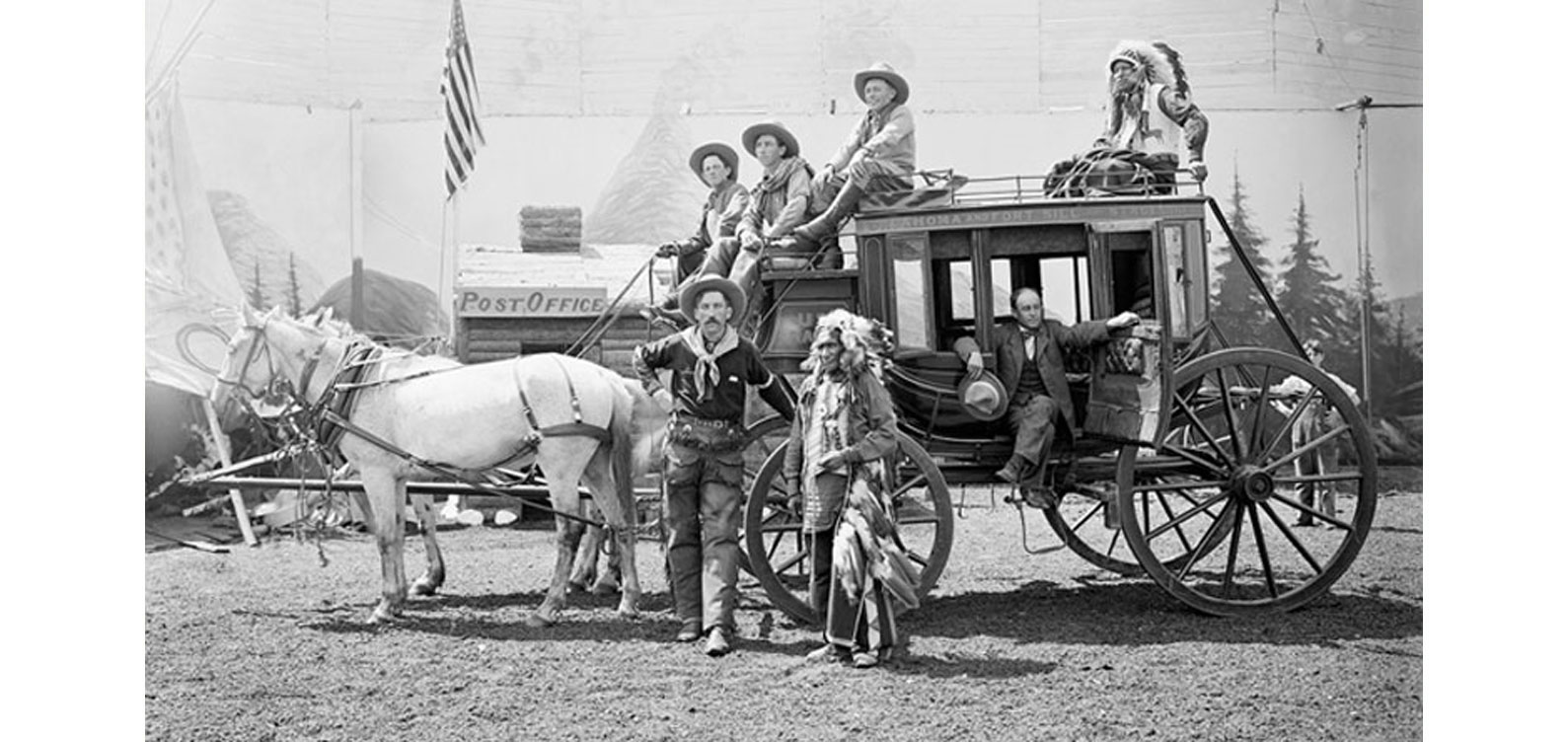
Interestingly, Fort Yuma was closely associated with the Yuma Quartermaster Depot on the Arizona side of the river - 11 miles north from present-day home of the Marine Corps Air Station Yuma (which today supports 80% of the Corps' air-to-ground aviation training). The U.S. Army Proving Ground Yuma is just above the northeast edge of the Fort Yuma Indian Reservation.
By 1866, the stagecoach lines were opened up to the public and daily service arrived and departed from Fort Worth’s 81 room El Paso Hotel on Main Street - opened in 1877 one year after the citizens and military finished the railroad tracks. The El Paso Hotel once stood within a block of today's Sundance Square.


It is important to note that the stagecoach line and the railroad was closely tied to each other. And if it wasn't for the Fort Worth citizens and military who finished the last 30 miles of railroad track to Fort Worth, the stagecoach hub would likely have landed in a different city.
In the drawing below is viewing the fort (Camp Worth) in 1876 from the North looking South (Trinity River in the foreground). As you can see, many structures had been built around the fort which would become Downtown Fort Worth today.

FORT WORTH + TEXAS AND PACIFIC RAILWAY
In 1876, when the citizens and military of Fort Worth finished the last 30 miles of the railroad track, the Texas and Pacific Railway arrived in Fort Worth. This arrival caused a boom in transforming the Fort Worth Stockyards into a premier cattle industry center of wholesale trade. The arrival of the railroad ushered in an era of tremendous growth, as migrants from other areas of the war-torn South continued to swell the population. Fort Worth had a lot to offer and supplied a regional market via the now rapidly growing transportation market and stockyards.

When the rail line was completed to Fort Worth in 1876, the city simultaneously became the largest stagecoach terminus in the Southwest. In 1878 the Fort Worth and Fort Yuma stage line was officially established, providing transportation and mail delivery on what they called a "star route” to Yuma, Arizona. The six-horse team pulled the stage 1,560 miles on a 17-day trip, the longest daily stage line in existence anywhere. And at the same time, Texas and Pacific Railway made Fort Worth its eastern terminus for their rail line from San Diego in 1876. This was huge for everyone in Fort Worth strengthening the stronghold and growth for the military, major railway, and stagecoach travel hub, and the explosion of the Fort Worth Stockyards.

h
All cities in the U.S. took notice. There was something very special about Fort Worth. As you can see in this map below, Fort Worth had become a major railroad hub by 1889 with the original Texas & Pacific Railway, the Fort Worth & Denver City Railway, the Gulf Colorado & Santa Fe Railway, the Missouri Kansas & Texas Railroad, the Missouri Pacific Railroad, the Fort Worth & New Orleans Railway, the Gulf Colorado & Santa Fe Railway, and the Fort Worth & Rio Grande Railway. This allowed for troops to get to and from the Fort Worth military base.
Note: If you look at the train map below, THIS is where the Fort Worth Tarantula Steam Train got its name. In fact, the below photo is titled, "Buckley B. Paddock's 1886 Tarantula Map". The Tarntula is now called the Grapevine Vintage Railroad, though Fort Worth locals still call it the Tarantula. You can still ride the old Tarantula Steam Train boarding on Main Street in Grapevine and travels to Fort Worth Stockyards and back on the old tracks of the Missouri Pacific Railway.

Fort Town, Stagecoach Town, and Cow Town are the three titles that tell the story of the first three decades of Fort Worth.

FORT WORTH + HELL'S HALF ACRE
In the early 1870's, with Fort Worth becoming a major hub with stagecoaches, trains, and cattle drives, the city would soon become host to one of the most famous red light districts in the US. With brothels, gambling parlors, and saloons, it would soon become known as “Hell’s Half Acre." At the end of the Civil War, returning soldiers may have brought the phrase "Hell's Half Acre" back with them from such bloody battlefields as Stones River (Tennessee's river site of one of the bloodiest battles of the Civil War), where it had been applied with a different but equally vivid connotation. It was usually shortened to "the Acre" but everyone knew what the abbreviation stood for. Fort Worth would become the wild, wild west attracting outlaws and lawlessness. Prominently dominating the town, it would be the first thing trail drivers would see as they approached the city from the south, west, and east during the city's heydey as a drover's stop on the cattle trails.
Take note of the sleeping panther on top of map...

It began on the lower end of Rusk Street (renamed Commerce in 1917) but kept growing in all directions. In 1881, the Fort Worth Democrat complained that it covered two and a half acres. It eventually grew from the west to east covering Throckmorton to Jones Streets - and covering the area from 8th Street to the north all the way down to 15th (or Front) Street to the south - right next to the Union Station train depot. Fort Worth's famous red light district was host to the most famous and infamous westerners visited Hell's Half Acre: Timothy “Longhair Jim” Courtright (who would later become Fort Worth's first Marshal), Luke Short, Bat Masterson, Wyatt Earp, Doc Holliday, Sam Bass, Mary Porter, along with Butch Cassidy and his Wild Bunch. While most of these outlaws and gunslingers are well-known, others may not - including Courtright, Short, and Bass.

Longhair Jim Courtright would be actively recruited as the very first Fort Worth Marshal, and his widely known status as a superb gunfighter, law and order was finally established. Plus he had to get a haircut. Even the hardest of criminals in the Acre feared him and murder in Fort Worth was cut in half. After receiving information that train and stagecoach robbers, such as the Sam Bass gang, were using the Acre as a hideout, Marshal Courtright intensified law enforcement efforts. But it is said that Courtwright turned his force into a racket, extorting money from all of the saloons and brothels in exchange for protection. On 8 February 1887, when Courtright went to White Elephant Salloon and tried to extort Luke Short, Short refused and the Fort Worth Marshal was not happy about it. Courtright decided he was going to make an example out of Short and called him out to the street to have a little 'chat'. Courtright intended to kill Short in front of everyone and show who was in charge. Courtright walked him down to in front of Ella Blackwell's Shooting Gallery. They stood face to face about four feet apart when a gunfight ensued and Short shoots and kills Courtright. Courtright had drawn first, but they say his gun got caught "for a second" on the chain of his fancy pocket watch. Courtwright did not get one shot off - while Short shot Courtright five times. The first shot blew the thumb off of Courtright's shooting hand, and when Courtright tried to switch hands with the gun, Short fired 4 additional quick shots and Courtright dropped to the ground, dead. Of the witnesses of the gunfight, Bat Masterson was there and saw the whole thing. Short was arrested for the shooting of the Fort Worth Marshal - but charges would be later dismissed as it was deemed self-defense.

Sam Bass, the notorious train and stagecoach robber, who first robbed the Union Pacific Railroad gold train from San Francisco, intercepting the gold train in Big Springs, Nebraska, and looting $60,000 - the single largest robbery of the Union Pacific. With all this gold, he decided he and his gang could relax for awhile in Hell's Half Acre. But that wouldn't last long because robbers got to rob - so in 1878, Sam and his gang held up two stagecoaches and four trains in Allen, Texas (north of Dallas). This would be his fatal mistake - because here, we had the Texas Rangers. Bass became the focus of a major Texas Ranger manhunt that ended with Sam Bass being gunned down by Texas Rangers in Round Rock, Texas.
Note: No genetic connection could be found between notorious bad guy Sam Bass and the Fort Worth Bass family of Sid Bass and his brothers Edward, Robert, and Lee, who inherited a small fortune from their oil tycoon uncle Sid Richardson and turned it into billions - and who have made generous contributions to Fort Worth.

The name "Hell's Half Acre" was abbreviated to "The Acre" by locals. Near the location today is a Fort Worth brewing company called "Acre Distilling Company" at 1309 Calhoun Street - which is actually located within the perimiters of Hell's Half Acre boundaries.
There is also another Fort Worth brewing company called "Wild Acre Brewing Company" at 1734 E. El Paso Street - located close by just east off of Lancaster.
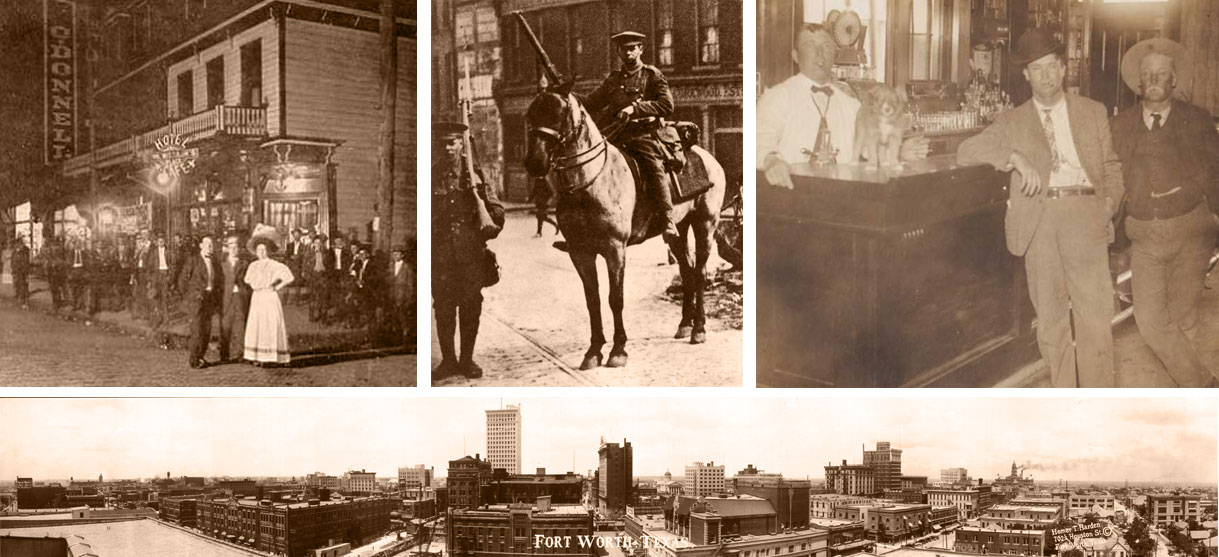
Today, the land upon which Hell’s Half Acre once existed is mostly the home of the Fort Worth Convention Center

Note: The location of the Acre Distilling Company is indicated by a red square on the map above. There is also a historical landmark plaque in the 1200 block of Houston Street on the convention center grounds (indicated by the red circle on the map above near the corner of 12th and Houston Streets).
FORT WORTH'S HEAVEN AND HELL
Ironically, the location of the most famous red light district, where thousands of people would come from all over the country to visit the gambling parlors, brothels, drink at the saloons, and kill or be killed in a drunken gunfight, is now the home of Kenneth Copeland's Annual Southwest Believers' Convention where thousands of people come from all over the country to pray and praise the Lord. Now there's a deep contrast.

But Fort Worth has been home of the contrast between good and evil long before Kenneth Copeland came to town (Copeland was born in Lubbock in 1936, grew up in Fort Worth, and established his ministry in 1967). First there was Reverend J. Norris and the First Baptist Church of Fort Worth, located just one block from Hell's Half Acre - and he was determined to take it down.
REVEREND J. FRANK NORRIS TAKES ON HELL'S HALF ACRE
In 1911, Reverend J Frank Norris launched an offensive against Hell's Half Acre and Fort Worth's racetrack gambling and used the pulpit of the First Baptist Church of Fort Worth to attack prostitution and vice. Reverend Norris used the Acre to scourge the leadership of Fort Worth - and when he began to link specific Fort Worth businessmen as property owners in the Acre, he announced their names from his pulpit. The battle between good and evil heated up. On 4 February 1912, Reverend Norris's church was burned to the ground - and that evening, someone tossed a bundle of burning oiled rags onto his porch of his parsonage, but the fire was extinguished and caused minimal damage. A month later, the arsonists succeeded in burning down Reverend Norris' parsonage. His congregation would rebuild the church.

In a sensational trial lasting a month, Pastor Norris was the one charged with perjury and arson in connection with the two fires. He was acquitted, but his continued attacks on the Acre accomplished little until 1917 when the federal government, which was eyeing Fort Worth as a potential site for a major military training camp (Camp Bowie), finally brought down the final curtain on the Acre by enacting martial law.

Reverend Norris was also the radio pastor of several radio stations where he started the very first regular radio ministry in the United States in the early 1920s on Fort Worth's WPA. Yes, Fort Worth is the "Birthplace of Christian Radio". Kenneth Copeland must have followed his lead by launching the BVOVN Network (Believers' Voice of Victory) which has 24/7 programming on radio, television, and online with over 3.5 billion viewers.
FORT WORTH + SOUTHWESTERN BAPTIST SEMINARY
Though originally founded in Waco in 1901, the Southwestern Baptist Theological Seminary was persuaded by Fort Worth Reverend Norris to move the Southern Baptist Convention's Seminary from Waco to Fort Worth in 1910. Southwestern Baptist Theological Seminary is just 5.5 miles from the previous location of Fort Worth's Hell's Half Acre and only 2 miles from Texas Christian University.
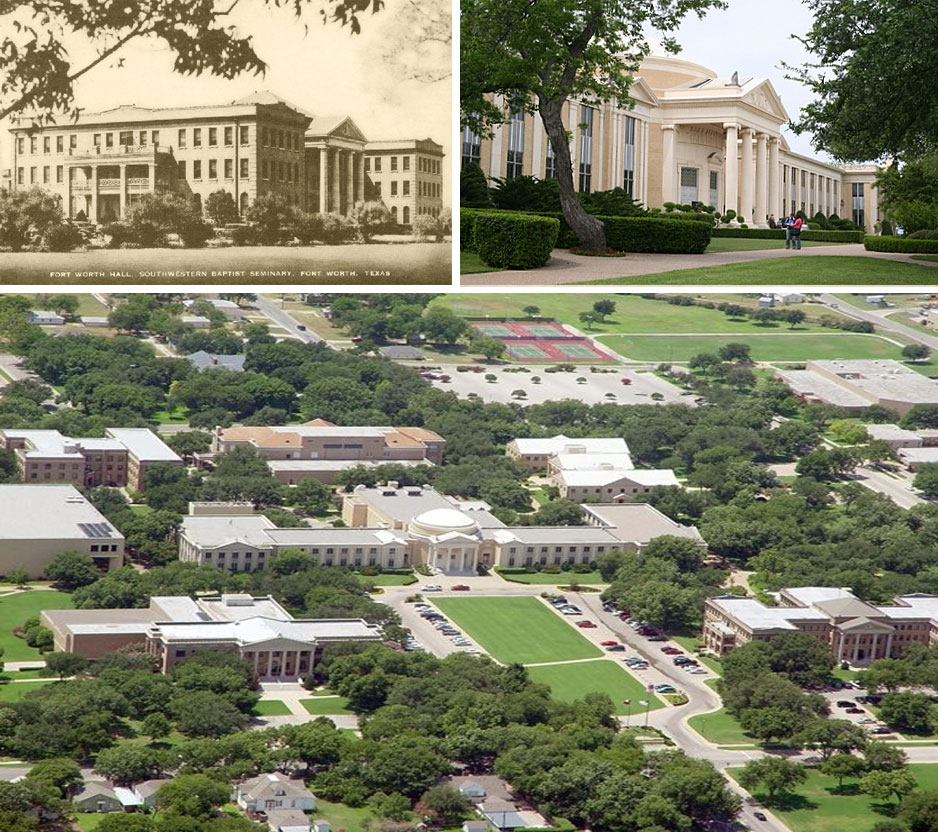
THE SHOOTING SALVATIONIST
Reverend Norris was known to many as the "most prominent man of God in the south" - but since his enemies used guns, so did he. He would become known as "The Shooting Salvationist". Reverend Norris' church became the largest church membership in the world under one pastorate in 1949. Among notables who spoke from his podium included former President Taft, Colonel Billy Mitchell, and humorist Will Rogers.
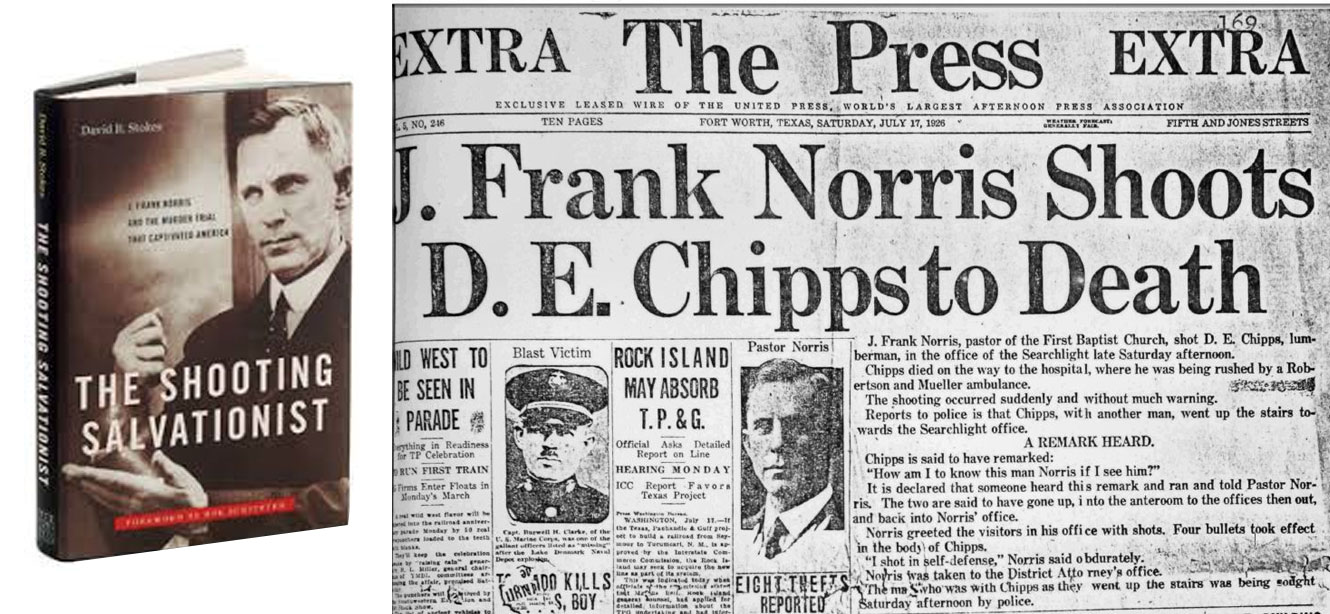
After 43 years behind the pulpit, Reverend Norris died in 1952 and is buried at Fort Worth's Greenwood Cemetery - and his tombstone reads,
"I would do anything to keep a man out of hell."
Fort Worth was a wide-open gambling town in the 1870s where respectability and rowdiness lived side by side. "Plenty of people were both rough and tough – AND respectable,” read a 1949 Fort Worth Press article reflecting on the long gone Hell's Half Acre. And eventually the good times would come to an end for the Acre when martial law implemented in 1917 by the US government prior to setting up the Camp Bowie Army Camp for WWI. Reverend Norris was pleased.
But that would only last for 25 years...
GANGSTERS & GAMBLERS ON THUNDER ROAD
Now back to the other side of good and evil, with The Acre long gone, gambling, booze, prostitution, and wild times would find a new home in the 1940s and 1950s – a three and half mile strip of Jacksboro Highway.

This strip was also known as "Thunder Road", Fort Worth’s updated version of Hell’s Half Acre. This infamous three and a half mile strip stretched from Northside Drive and present-day Loop 820. The earliest (and some say "most respectable") joint was the Double Duece at 2222 Jacksboro Highway. Poker legend Doyle Brunson referred to it as "Bloodthirsty Highway".
You can bet Reverend J. Frank Norris was not too pleased about this (he was 73 when he died in 1952).
Instead of "Outlaws", Fort Worth now had "Gangsters".

JACK RUBY + THUNDER ROAD
When most people think of Jack Ruby, they think of Dallas and his Carousel Club Strip Joint - but did you know that he also owned the Skyline Lounge (aka "Skyliner Club" and "Skyliner Ballroom") in Fort Worth on Jacksboro Highway? Well it's true. Jack Ruby's 'entertainers' Candy Barr, Tammi True, and Sherry Lynn would rotate shifts between Fort Worth and Dallas. This three and a half mile strip sported 18 restaurants, six liquor stores, seven nightclubs, and 10 motels. The Skyliner Ballroom, one of the wildest and most colorful clubs on the strip, was originally established in the late 1930s, but ownership changed hands to Jack Ruby at some point.

The most popular clubs on Thunder Road included the Rocket Club, Skyline Lounge, Four Deuces, Top of the Hill, The Dunes, Sands Supper Club, Ann's Club, Magic Lounge, Massey's, Coconut Grove Nightclub the Black Sands, the Palm, and the Yellow Jacket, among others. Interesting to note that in the early years of Thunder Road (early 1940s) the head bouncer at the Coconut Grove Nightclub was the famous James Ralph "Sully" Montgomery, former NFL player and heavyweight boxer. Sully boxed professionally for twelve years and his heavyweight career ended when Jack Dempsey defeated him. Sully was born in Fort Worth and played football for Northside High School before three years in the NFL and professional boxing. Sully would later become the Sheriff of Tarrant County (1947 to 1953). Sully was later appointed and served as Chief Deputy in a constable’s office from 1956 to 1970.

Thunder Road would bring the mob to Fort Worth and Sheriff Sully would have to deal with them. Characters like Jack "The Wannabe Mobster" Ruby, Benny "The Cowboy" Binion, Herbert "The Cat" Noble, and Mickey "the West Coast Mobster" Cohen. Candy Barr, Jack Ruby's star dancer, was romantically involved with Las Vegas mobster Mickey Cohen, who routinely visited Fort Worth and Thunder Road.

But Mickey Cohen didn't come to Texas just to see Candy Barr, it was the fact that Texas continued to be active and good money could be made, legally or illegally. The West Coast mobster had a strong interest in branching out to Texas, which Cohen claimed to be that of an oil deal". Just like Sam Bass, the Texas Rangers were soon on his trail.
THE TEXAS GAMBLING WAR
It didn't take long before Dallas mobsters Herbert "The Cat" Noble and Benny "The Cowboy" Binion fought to control the gambling rackets in Fort Worth. Noble was in Fort Worth negotiating the purchase of an old Air Force training center called Hicks Field when the fifth attempt was made on his life. But he had taken his wife's car that day - and his car at his Oak Cliff home blew up when his wife went to start it. He was convinced the bomb that killed his wife was planted by Benny Binion’s gang, and revenge became his solitary obsession. On the 9th attempt, "The Cat" would be gunned down as he was making his final inspection on his plane which was prepped for a trip to end Binion. Benny Binion was questioned by police but he denied any involvement. This period would be later known as the "Texas Gambling War".

Ultimately, Herbert "The Cat" Noble gets gunned down in Oak Cliff, Jack Ruby becomes world-famous by shooting Oswald and then dies mysteriously in Dallas jail, Mickey Cohen goes to Alcatraz for tax evasion, and Benny "The Cowboy" Binion moves on to Las Vegas and builds the world famous Horseshoe Club Casino and casino empire. And while the gangsters and gamblers on Thunder Road are long gone, it definitely adds to the very colorful past of Fort Worth.

LAKE WORTH CASINO BEACH CASINO
History has it that gambling on Thunder Road was originally set up to compete with the Casino Beach Casino on Lake Worth on the other side of the bridge on Jacksboro Highway/Lake Worth Boulevard. In addition to the casino, there was a rollercoaster, a beach, and lots of activities for everyone.

While the Casino is long gone, there is still "Casino Beach Park" in the same location.
THE LAKE WORTH MONSTER
It seems that Casino Beach began to lose its appeal in July of 1969 (at the peak of the summer season) when there surfaced multiple sightings by local citizens of a "half-man, half-goat, with fur and scales" which led to the belief that a mysterious creature lived in Lake Worth ready to attack and kill you. This legend became known as "The Lake Worth Monster". On the night of 10 July 1969, a few dozen people were at a clearing known for dumping near the lake when the monster made another appearance. It appeared on a cliff, looked angry, and threw a tire 500 feet. Everyone, including a group of sheriff’s deputies, ran away in fear. While most considered it a hoax, many were afraid to go into the water, even to this day.

Real or imagined, the Lake Worth Monster is still feared over 4 decades later. Interestingly, the shores of Lake Worth is home to Carswell/Naval Air Station - but no military member ever reported seeing the legendary monster.
FORT WORTH + FUNKYTOWN
Another nickname locals and visitors alike call Fort Worth is “Funky Town", though the year of origin is unclear. Some say it was hip-hop slang for Fort Worth that emerged 20 years ago around 1997. Others say it is referencing the amazing music that has come out of this city. Some say it's because Fort Worth has some of the most talented artists, musicians, actors, chefs, and entrepreneurs in the county. Some say it's because of all the famous musicians who perform in Fort Worth annually. Some use the slogan "Keep Fort Worth Funky".
In line with Fort Worth's long-standing positive artistic momentum, a new event to begin in 2017 is the Funkytown Music & Film Festival. Founded by Carlos Aguilar and Adonis Rose, Funkytown Music & Film Festival is a cultural amplification of all the vibrancy and growth that is happening today in Fort Worth, Texas, and will be a destination event in North Texas, hosting world renowned talent, Texas talent, and entertainment industry influencers that are also committed to the long-term goal of developing our next generation of filmmakers, musicians and artists. Their mission and vision is to be a platform for music and film education and preservation, while highlighting the city’s rich creative history.

Other Fort Worth companies have also used the "Funkytown" nickname in their business, events, and theme names like "Keep Fort Worth Funky".

THE EVOLUTION OF FORT WORTH
The military fort that was named "Fort Worth" (1849) and the "Fort Worth" we call home today (2017) have gone through many dramatic changes in 168 years. But at the center of it all is ground zero of the birth of a city - the exact location where the Tarrant County Courthouse stands today. Perfectly located just south of the Trinty River where West Fork and Clear Fork converge, up on the hill between N. Houston Street and Commerce Street, and between E. Belknap and E. Weatherford Streets. The camp is long gone. The first courthouse is long gone. but the structure erected in 1894 still stands in all its glory. And while our city grows with leaps and bounds, this very spot is the center of our beginning.

And most don't know that the final resting place of our city's founding fathers is only 0.7 miles away at Pioneer's Rest Cemetery - including Major Ripley A. Arnold and his family, General Edward H. Tarrant, 11 soldiers who died at the original fort site from 1849 to 1850, Captain Ephraim M. Daggett and his family, Jesse Shelton Zane-Cettis (who organized and led the citizen/miltary effort to finish the last 30 miles of railroad track for the Texas and Pacific Railway) and his family, Dr. Carroll Marion Peak (the very first doctor in Fort Worth who arrived in 1854), Captain Junius "June" Peak, the Texas Rangers, the Peak family, General James J. Byrne (who was the youngest general in the Union Army), and over 75 Civil War soldiers who were based in Fort Worth.
Buried just two miles north from the Tarrant County Courthouse is the Oakwood Cemetery, the final resting place of Major Horace S. Carswell, Jr. (Northside HS graduate, TCU graduate, Medal of Honor recipient, and namesake for Carswell Air Force Base), Longhaired Jim Courtright (the famous gunslinger and first Fort Worth Marshal, among others.
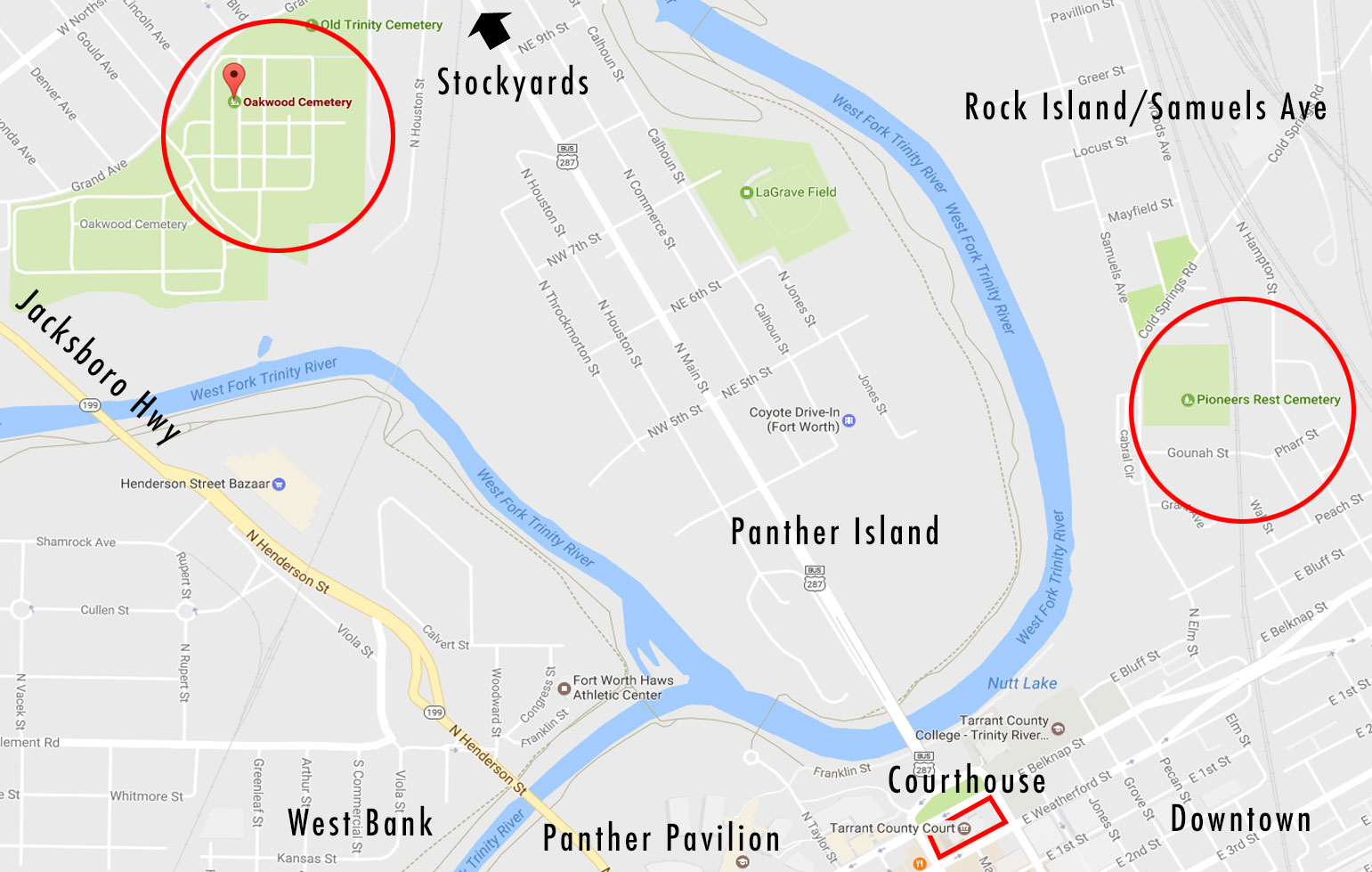
Here is an illustration of downtown Fort Worth in 1886, just 10 years after Dallas predicted that Fort Worth would collapse:

FORT WORTH + ROCK ISLAND + SAMUELS AVENUE
The Samuels Avenue neighborhood of Fort Worth was also known as "Rock Island" and "The North End" and was the first wealthy neighborhood of the Cattle Barrons of the Stockyards. It was once land owned by Baldwin L. Samuel who had lived in the area by at least 1850 and purchased the land in 1870 from Nathaniel Terry who had previously served as lieutenant Governor of Alabama. When he died in 1879, the road from his plantation to downtown was named in his honor, and was buried right there at Pioneer's Rest Cemetery.
Samuels Avenue neighborood is located just northeast of downtown Fort Worth between the Trinity River and Interstate 35W. The neighborhood was built right on the hill along side the Trinity River. While many of the early grand mansions have been replaced with new multi-family residential development, there are some of these mansions still standing. In the 1886 illustration below, you can see the square of Pioneer's Rest Cemetary, the mansions along the Trinity River, Cold Springs Road, and the driving park. The Fort Worth driving park was located where a county jail facility is today and just above the park was Fort Worth's first trolley park. The larger two-story building in the center was a brothel run by a woman named Frankie Brown and called it the "Steamboat Gothic House" on Cold Springs Road - the location where Major Ripley Arnold Park is today.

FORT WORTH + PIONEER REST CEMETERY
Pioneer's Rest Cemetery is the resting place of Major Ripley A. Arnold (the 'Father of Fort Worth'), General Edward H. Tarrant (namesake for Tarrant County), and are over 75 Civil War Veterans. There are also gravesites of 11 soldiers who died at the original fort (Camp Worth) from 1849 to 1850. In addition to the many Fort Worth Veterans who fought in early battles, Pioneer's Rest Cemetery is also the resting place for most famous families in Fort Worth history, including the Daggetts (Captain Ephraim Merrill Daggett), Zane-Cettis (Jesse Shelton Zane-Cetti who built the Texas Brewing Company on Hell's Half Acre), and the Peaks (Captain Junius "June" Peak, Confederate Army and the Texas Rangers). Pioneer's Rest Cemetery is the oldest cemetery in Fort Worth. General James J. Byrne, buried at Pioneers Rest Cemetery, was the youngest general in the Union Army. On the map below, you can also see Oakwood Cemetary - the final resting place of Hell's Half Acre's famous Jim Courtright and Luke Short, Fort Worth's first Marshal who was gunned down by Luke Short.
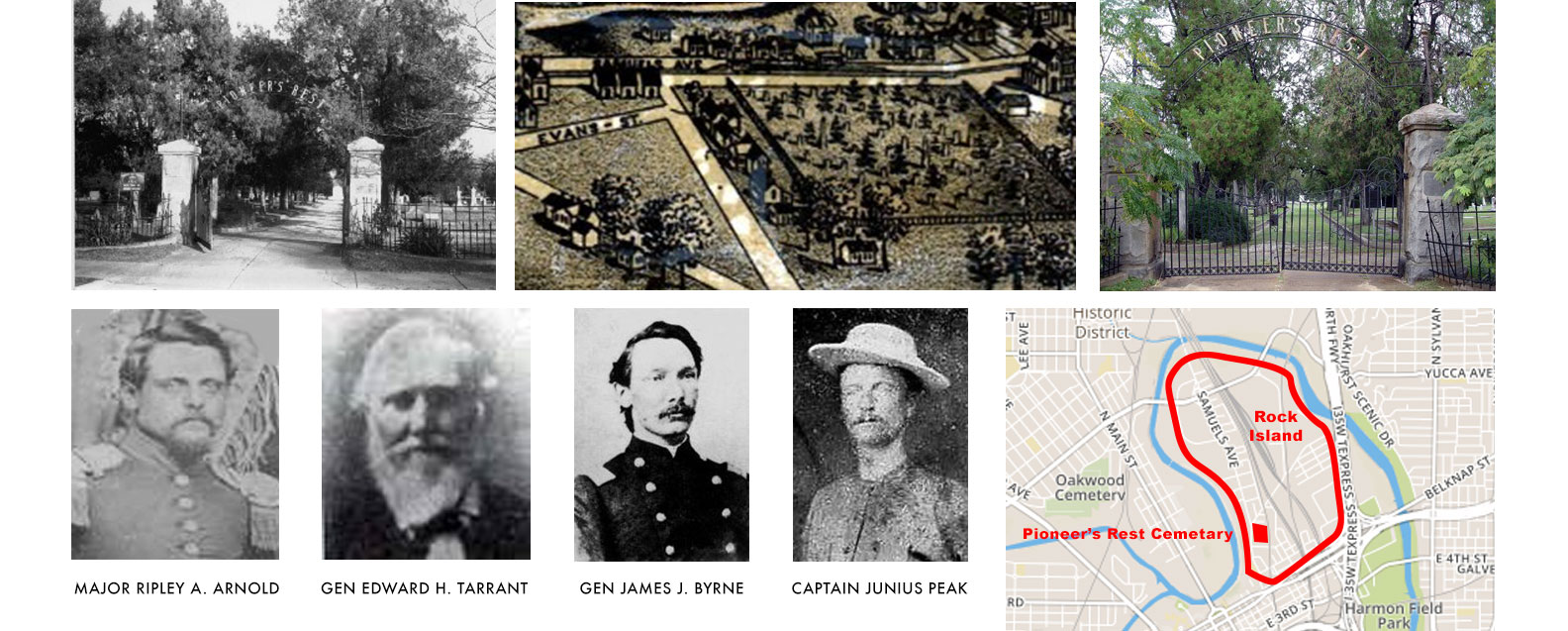
Here is illustration from 1891 that highlights Hell's Half Acre, the Tarrant County Courthouse, "Quality Hill", and "Spring Palace".

FORT WORTH + QUALITY HILL
Following the original Cattle Barron mansions of Rock Island/Samuels Avenue, Fort Worth's next enclave of wealthy Cattle Barron Mansions was "Quality Hill", located just southwest of downtown and just east and northeast of the Camp Bowie military camp.

The mansions of Quality Hill were bordered to the north by West 7th Street, to the east by Henderson Street, to the south by Pennsylvania, and to the west by Summit Avenue and Penn Street. Only a few of these amazing mansions remain - including one that is now home to the Historic Fort Worth, Inc, the original Ball-Eddleman-McFarland House built in 1899 (1110 Penn Street). There is also a row of these mansions still standing, fully restored on Pennsylvania Avenue, across the street from the hospital and the historic Thistle Hill Mansion (1509 Pennsylvania Avenue).
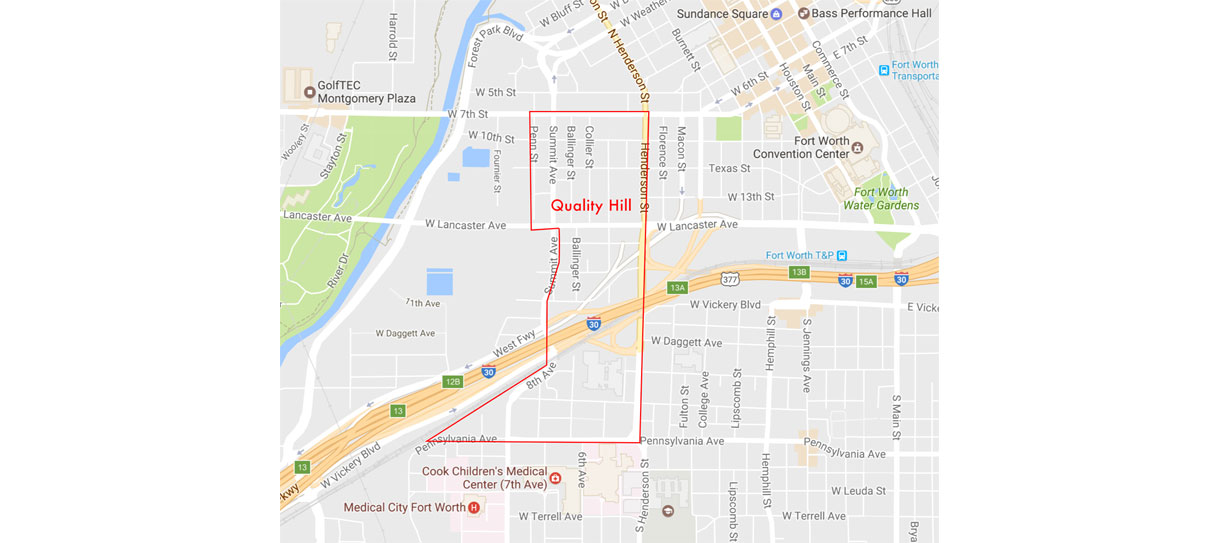
FORT WORTH + SPRING PALACE
"Spring Palace" was built during the downtown construction boom and was intended to bring even more attention to Fort Worth. The Spring Palace was built in 1889 - but unfortunately burned to the ground just one year later. The Spring Palace (also known as "Corn Palace") burned to the ground in 1890. But it shouldn't have come as a surprise - the building was a wood structure covered in wheat, corn stalks, moss and Johnson grass treated with kerosene.
Ironically, the President of Spring Palace was Buckley B. Paddock - the same city leader who organized the very first all-volunteer firefighters in Fort Worth in 1873. The Weekly Gazette reported, "the last person to leave the flaming building was Spring Palace president Paddock - as people fled the fire, Paddock stood at the band stand urging calm, like the captain at the bridge of a sinking ship." Yes, Paddock was the president of Spring Palace AND present when it burned down...
Today there is a monument honoring Alfred S. Hayne, who repeatedly entered the building to save people trapped inside. He was the only one who perished in the fire when he rushed into the blaze to look for a child who had already escaped. Born in London, Alfred "Al" Hayne was a railroad bridge designer and Fort Worth resident working on the Texas & Pacific Railway. The Hayne Monument can be seen at W Lancaster and Houston in the same spot it was erected in 1893. His final resting place is at Fort Worth's Oakwood Cemetery.
It would be three years later before Fort Worth established their first full-time fire department (1893), replacing the all-volunteer firefighters.
Ironically again, some news accounts state that Al Hayne served as one of Fort Worth's volunteer firefighters - there are even the firefighter icons of hook and ladder and helmet at the top of his monument...

As you can see in the following early 1900s photo, there was a huge boom in Fort Worth in a relatively short period. Here we see taller buildings, horse-drawn buggies, streetcars, and bicycles in downtown Fort Worth (looking North on Houston Street). In another contrast that best describes Fort Worth, you see the Lyric Theatre on the left - directly across the street from the AJ Anderson Company's Gun Store on the right. And you also see competing national brands Dr. Pepper and Coca-Cola on left - and Hotel Melba on the right:

FORT WORTH + LONGEST-RUNNING STOCKSHOW
Because Fort Worth had become a major hub for the military, stagecoach lines, railroad, and Chisholm Trail, the city became the main hub for cattle and the Stockyards. This cattle also fed the troops based here in Fort Worth at the various camps. It would make sense that the City of Fort Worth would host an annual stock show, originally called the "Fort Worth Fat Stock Show" and was held in 1896 - and because of its success, it has run continuously for over 120 years - the most famous and longest-running stock show in existence.
The Fort Worth Stock Show and Rodeo has always honored our Veterans - and they do this by hosting Military Appreciation Day with free grounds admissions and rodeo. The namesake for Will Rogers Memorial Stadium is of course William Penn Adair "Will" Rogers, a Cherokee Indian, whose father Clement Rogers was a Confederate soldier. Will Rogers attended Kemper Military School in Missouri. He was also an advocate for the aviation industry - and he is the namesake for Will Rogers Air National Guard Base located at Will Rogers World Airport as part of the Oklahoma Air National Guard.

The location of Will Rogers Memorial Stadium is the former home of Fort Worth's Camp Taliaferro (pronounced "Talaver") during World War I where England's Royal Flying Corps conducted their pilot training with the American pilots in 1917 and 1918. Camp Taliaferro was the headquarters for three air bases in Fort Worth - Hicks Field, Benbrook Field, and Everman Field.
The formal opening of the Armour and Swift meat packing plants in North Fort Worth (next to the Stockyards) coincided with the opening of the "Fort Worth Fat Stock Show" in 1903.
Out of deep respect for the military and to focus on supporting the war effort, there was no stock show in 1943 during World War II.
FORT WORTH + TCU + MILITARY
Texas Christian University (TCU) was originally founded by two military brothers, Addison and Randolph Clark, who had just returned from military service in the Civil War. Addison had served as an officer in the Confederacy since 1862, and Randolph would join the Sixteenth Texas Regiment in the Spring of 1864.

Addison and Randolph Clark moved their families and parents from Bonham to Fort Worth during the winter of 1868-1869. They operated their preparatory school, the Male & Female Seminary of Fort Worth, from 1869-1874. Even as they operated that school, they were also laying plans for a coeducational institution of higher learning in Fort Worth, AddRan Male & Female College. The fact that it was coeducational is notable because in 1870 higher education was mostly a male-only endeavor. In 1870, only 15% of the national college enrollment was female, and most of those were segregated in women’s colleges. TCU was one of the first coeducational institutions of higher education west of the Mississippi River, and the very first in Texas.
The Clarks bought five square blocks of downtown property from 8th to 13th streets between Calhoun and Jones – roughly where the parking lots fronting the Intermodal Transportation Center are today. Unfortunately, this was the same time period in which the Chisholm Trail cattle drives were beginning, which fueled rampant growth of the city’s vice district, Hell’s Half-Acre. The Acre was soon crowding right up to the edge of the Clark property, and they decided this was no place to found a college for young adults. They sold the Fort Worth property and bought a new property with a large stone building on it at Thorp Spring, about 2 miles northwest of Granbury. This is where AddRan College began in 1873. The name was changed to AddRan Christian University in 1889 and Texas Christian University in 1902.
In 1895, the Clarks moved the college to Waco to gain the advantages of a larger population and transportation center, but they were in Waco for only 15 years. In 1910, TCU’s main administration building burned down and the people of Waco made no offer of help toward rebuilding. An organized group of Fort Worth entrepreneurs offered a 50-acre campus and $200,000 (over $5 million in current dollars) to lure TCU back to the City of Fort Worth, which was the historic source of its institutional roots.

The TCU campus was built at its present location in Fort Worth in 1910 and consisted of the following buildings: Clark Hall, Goode Hall (the men's dormitories), Jarvis Hall (the women's dormitory), and the Main Administration building (now Reed Hall). Two of these original buildings still remain: Reed Hall (originally the Main Administration building) and Jarvis Hall (originally a women's dormitory), has since been renovated as an administrative building. Goode Hall was demolished in 1958 and replaced by the new Clark Hall (originally a men's dormitory), but renovated in 2008 as a coed residence hall. The original Clark Hall was demolished in 1959 and replaced by Sadler Hall, the current main administration building.

TCU's founding brothers were military Veterans. TCU has always been an educational partner to the US military and serves host to reserve officer training corps (ROTC) programs for two different service branches, the US Air Force ROTC's Detachment 845 "Flying Frogs" and the US Army ROTC's "Horned Frog Battalion". Each year, approximately 3% of TCU's graduating seniors go on to serve as commissioned officers in the US armed forces. During World War II, TCU was one of 131 colleges and universities nationally that took part in the V-12 Navy College Training Program which offered students a path to a Navy commission.
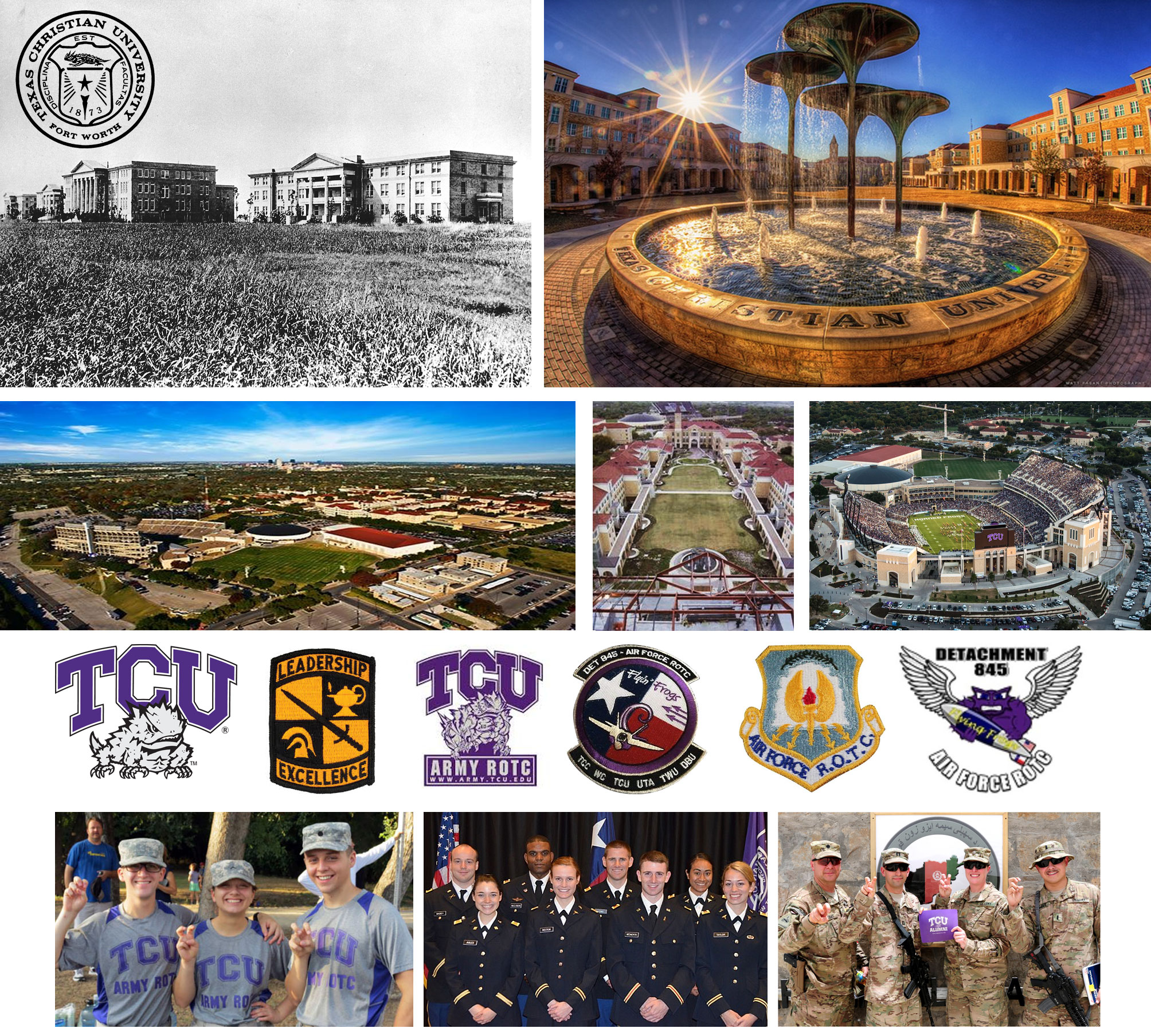
FORT WORTH + TCU + MEDAL OF HONOR
Many are not aware that later on in 1948, Army Air Field would be renamed Carswell Air Force Base after Medal of Honor recipient Major Horace S. Carswell, Jr. - who was a graduate of TCU before joining the Air Force.

FORT WORTH + TCU + SECRETARY OF THE NAVY
TCU MBA Grad Gordon R. England held several roles including president of General Dynamics in Fort Worth and was part of the transition over to Lockheed Martin. Mr. England served as 72nd and 73rd U.S. Secretary of the Navy, served as first Deputy Secretary of Homeland Security, andserved as the U.S. Deputy Secretary of Defense, and also as Acting Secretary of Defense in 2009. Mr. Gordon has also served on Fort Worth's city council, USO's Board of Governors, the Defense Science Board, the Board of Visitors at TCU, among many others. He is also currently a member of the Naval Order of the United States.
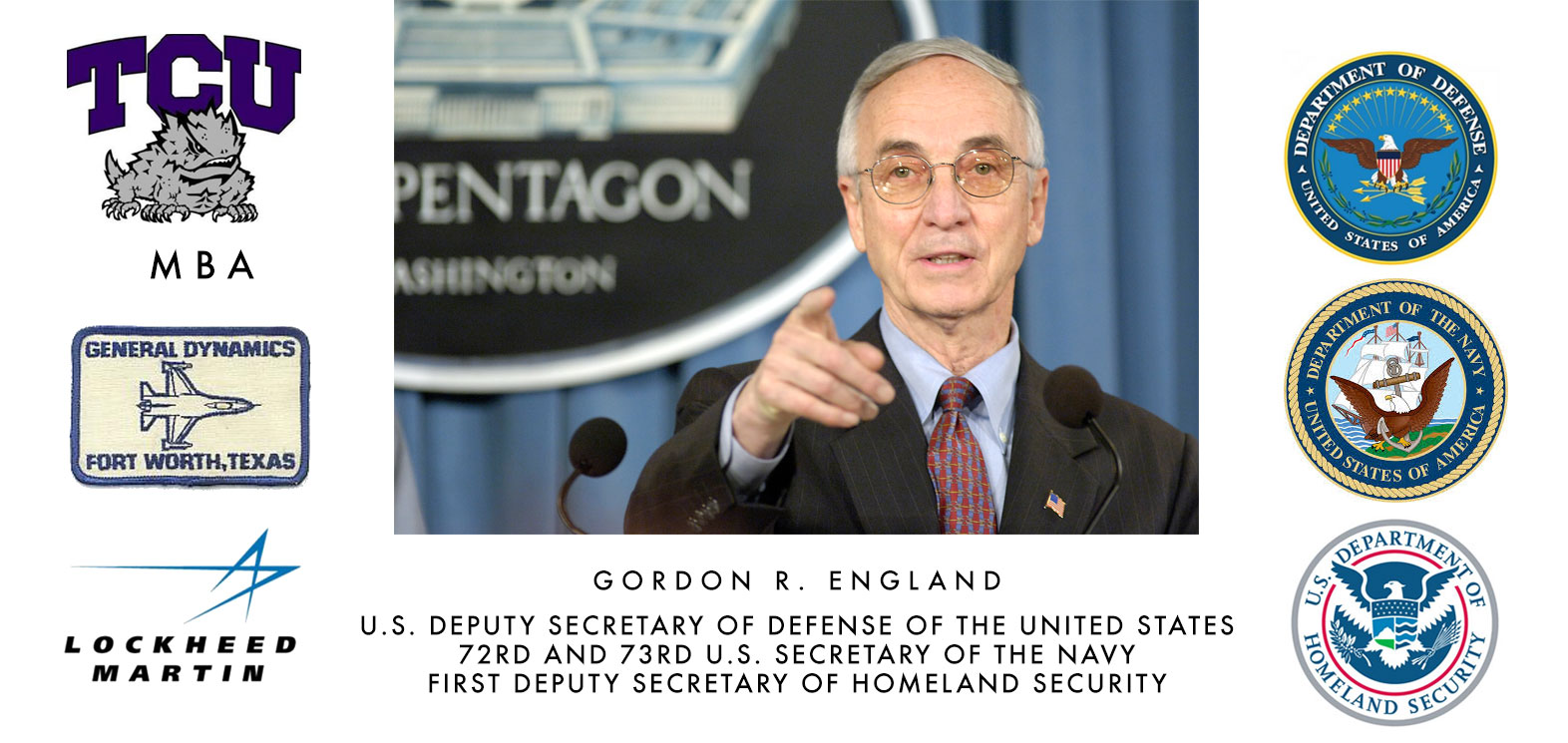
FORT WORTH + TCU + VETERANS PLAZA
TCU’s Veterans Plaza is a centerpiece constructed to honor the sacrifices and achievements of alumni and students who served in World War I, World War II, Korean War, Vietnam, Desert Storm, Iraq, and Afghanistan. Although a longtime campus memorial honored Horned Frogs who died during World Wars I and II, other TCU students and graduates did not have a campus marker to honor those who served, until the new Veterans Plaza was constructed and dedicated in 2005.

FORT WORTH + TCU + MILITARY SERVICE
Captain George Markos ’61, a Distinguished Military Graduate of Army ROTC and the first Tarrant County casualty from the Vietnam War.

Captain William Elmo Powell ’65, a TCU Air Force ROTC graduate, died when his plane was shot down by enemy fire in Vietnam in 1968.

Major Mitchell O. Sadler, Jr. ’65, an Air Force ROTC graduate, lost his life Laos in 1970.

Captain Tristan N. Aitken ’95, was a Distinguished Military Graduate of TCU's Army ROTC, and was killed in April 2003 in an ambush near the Baghdad airport.

Major M. Christopher Wingate (OF-3) is currently the US Army Commander of C/2-227 AVN REGT in Afghanistan.Major Wingate had previously served as Chief of Operations and MEDEVAC Operations Officer for 159th Combat Aviation Brigade, 101st Airborne Division. Major Wingate is a UH-60 Blackhawk Instructor Pilot and Pilot-in-Command. Major Wingate is a former TCU student and TCU football wide receiver from 1999 to 2003.

FORT WORTH + TCU + ARMED SERVICES BOWL
TCU's Amon G. Carter Stadium is also home to the Big 12 Conference's Lockheed Martin Armed Services Bowl. The bowl game was inaugurated in 2003 as the "Fort Worth Bowl", reflecting the sponsorship of PlainsCapital Bank. It was renamed to the "Armed Services Bowl" in 2006 and was sponsored by Bell Helicopter through 2013 (the "Bell Helicopter Armed Services Bowl"). In 2014 Lockheed Martin took over the sponsorship as "Lockheed Martin Armed Services Bowl".
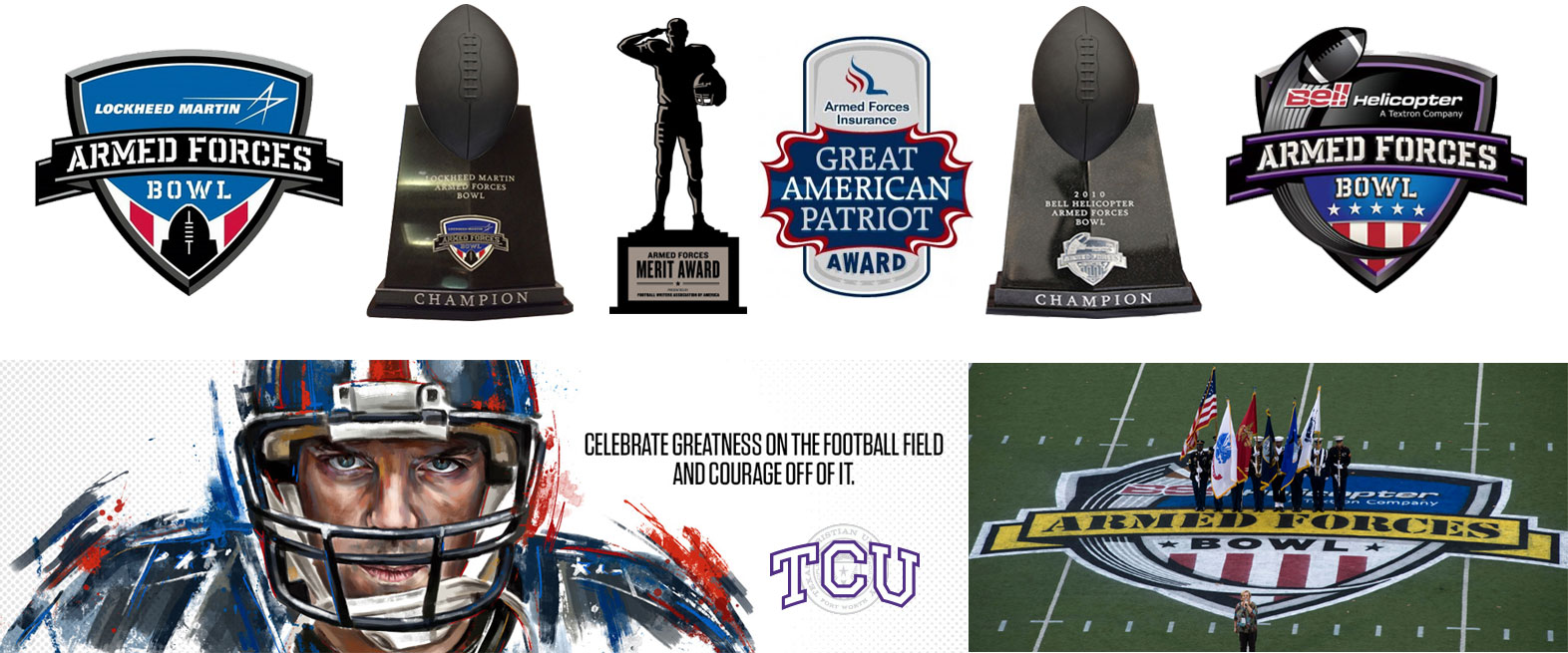
One of the coolest backstories is the construction of the Armed Service Bowl's champion trophy. It's no ordinary trophy. Forged from combat-used metal and the steel from all five branches of the United States Armed Forces, the battlefield is in the trophy's DNA. The Lockheed Martin Armed Forces Bowl trophy honors the courage and fortitude of our brothers and sisters in arms, and represents strength, honor, heroism, and sacrifice. The Lockheed Martin Armed Forces Bowl trophy is an iconic symbol befitting those who answer the call of duty for our nation.
FORT WORTH + WORLD WAR I
Ultimately, it was the United States' involvement in World War I that brought about Fort Worth's red light district's Hell's Half Acre's official demise. In 1917, Camp Bowie in Fort Worth was chosen to serve as a training ground for young soldiers soon to be shipped overseas. However, there was a stipulation:
Hell’s Half Acre would be shut down so as not to corrupt these brave young men.
In fact, martial law was imposed to ensure the deed was accomplished.
Here is a 1917 map of Camp Bowie military base. In it you will see Lake Como bottom left, and West 7th Street at Montgomery Street in the upper right. Note: Arlington Heights Bld. was renamed Camp Bowie Blvd. in 1921. At the top right you see the reference to the direction of Lake Worth. On the right you see the proximity to Trinity River, and at bottom you see the Texas and Pacific Railway tracks. and Clear Fork:


Camp Bowie was named after James "Jim" Bowie, a 19th-century pioneer, a firefighter, and frontiersman who played a prominent role in the Texas Revolution, cultimating in his death at the Battle of the Alamo. Have you ever heard of the Bowie knife? It's the same Bowie. This was a result of his rise to fame in 1827 on reports of the famous Sandbar Fight on the shores of the Mississippi in Louisiana. What began as a duel between two other men deteriorated into a melée in which Bowie, having been shot and stabbed, killed the sheriff of Rapides Parish with a large knife. This, and other stories of Bowie's prowess with a knife, led to the widespread popularity of the Bowie knife. The town of Bowie, Texas, northwest of Fort Worth, was also named after Jim Bowie.
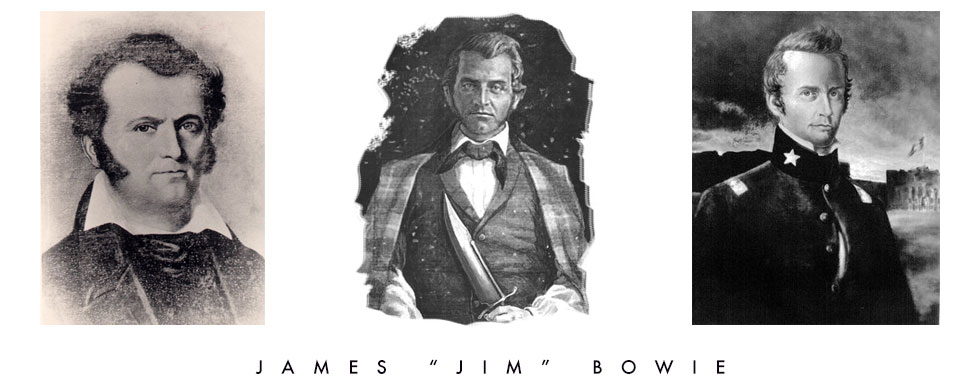
CAMP BOWIE TROOPS TO GERMANY
Camp Bowie troops head to Germany to fight in the war. Note: The Fort Worth news article below uses the name "Kaiser" in reference to the German Emperor Wilhelm Kaiser who was said to be the one who started World War I. The name "Sammies" is in reference to American soldiers. The context of the article is that every man, woman, and child must do their part to help the Sammies, the American soldiers.

During World War I, the U.S. Army's 36th Infantry Regiment (Texas and Oklahoma) trained at Camp Bowie. Here is an artist rendering of Camp Bowie troops in 1917:
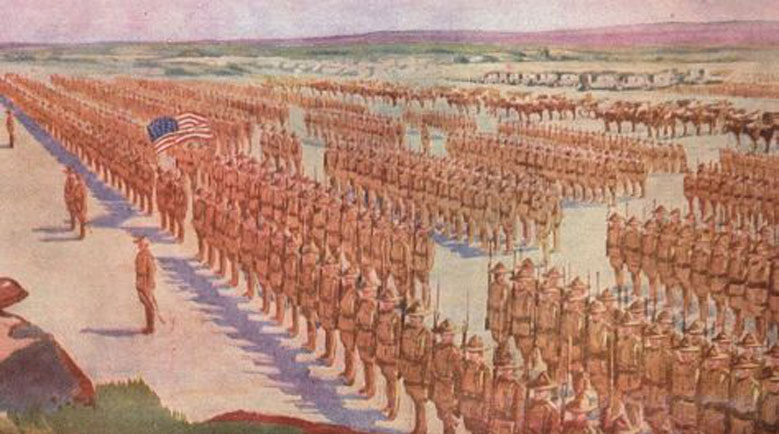
Here is a photo of the 144th Infantry at Camp Bowie in 1918:


Here is the Camp Bowie district in 1920s where you can see the trolley line system in the center of the boulevard to allow troops stationed at Camp Bowie move back and forth from downtown Fort Worth.

FORT WORTH + ROYAL FLYING CORPS
Did you know that there's a section of Fort Worth owned by England's British Commonwealth? This location is at Greenwood Memorial Park Cemetary off University Drive north of White Settlement Road.

In 1917, the U.S., British, and Canadian governments entered into a reciprocal agreement to train military pilots for combat duty for World War I. Foreign troops trained in Texas in the winter and in Canada in the summer. These pilots were based at Fort Worth's Camp Taliaferro which consisted of three air fields in Tarrant County.
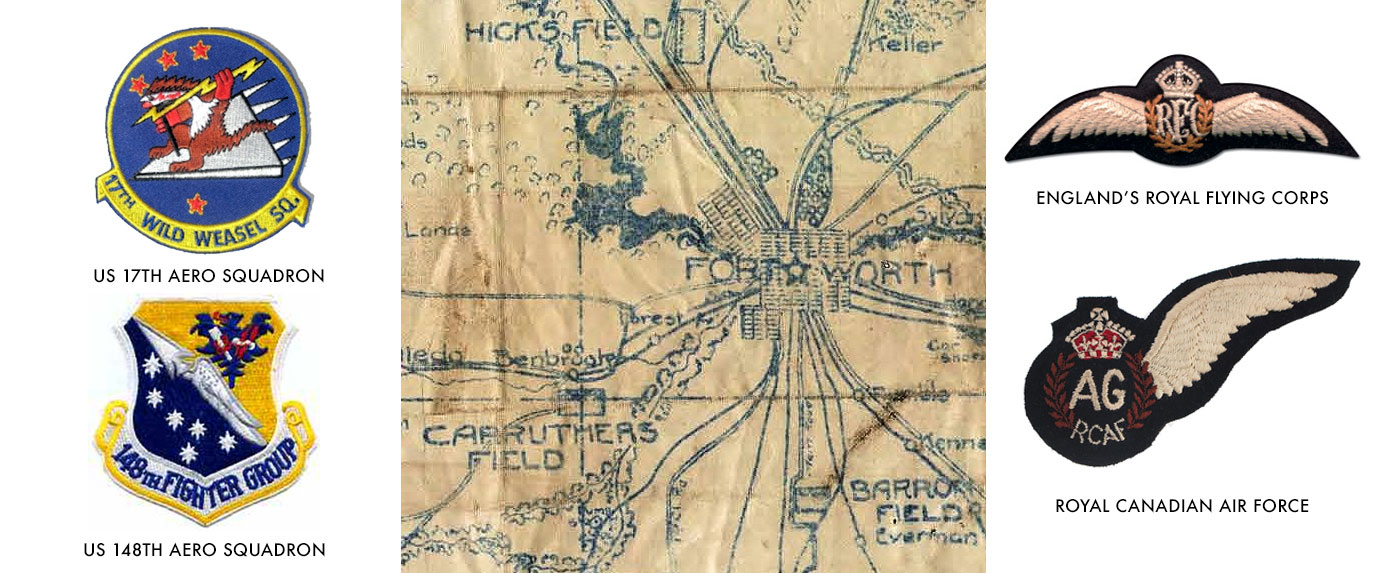
The 11 British pilots died during flight training while stationed at Camp Taliaferro in Fort Worth between 1917 and 1918. These 11 men were buried at the three different air fields. In 1924, the Imperial War Graves Commission purchased a plot at Greenwood Cemetery for reinterment. A monument was erected at the site - which now has 12 graves since a Veteran who died in 1975 requested burial with his friends.
FORT WORTH + CAMP TALIAFERRO
Camp Taliaferro and its three airstrips provided training facilities for the Royal Flying Corps and U.S. forces (1917-1918). Each field accommodated an average of 2,000 men. Royal Flying Corps expertise and skilled instructors enabled large numbers of Americans to receive superior flight training in a short time. They trained at Camp Taliaferro in Fort Worth headquartered at what is now the location of the Will Rogers Memorial Coliseum.
Camp Taliaferro had three air fields for pilot training - Hicks Airfield, Benbrook Field (renamed Carruthers Field after the RFC left), and Everman Field (renamed Barron Field).

Camp Taliaferro was named after US Army pilot Lietutenant Walter R. Taliaferro.

Below you will see a photo from the 1918 funeral of Captain Vernon W. Blyth Castle from Wing 3 Benbrook Field. Captain Castle was of the most notable pilots at Benbrook/Carruthers Field whose death shocked not only Benbrook and Fort Worth, but the entire nation. He was very talented stunt pilot who helped train the Royal Flying Corps.
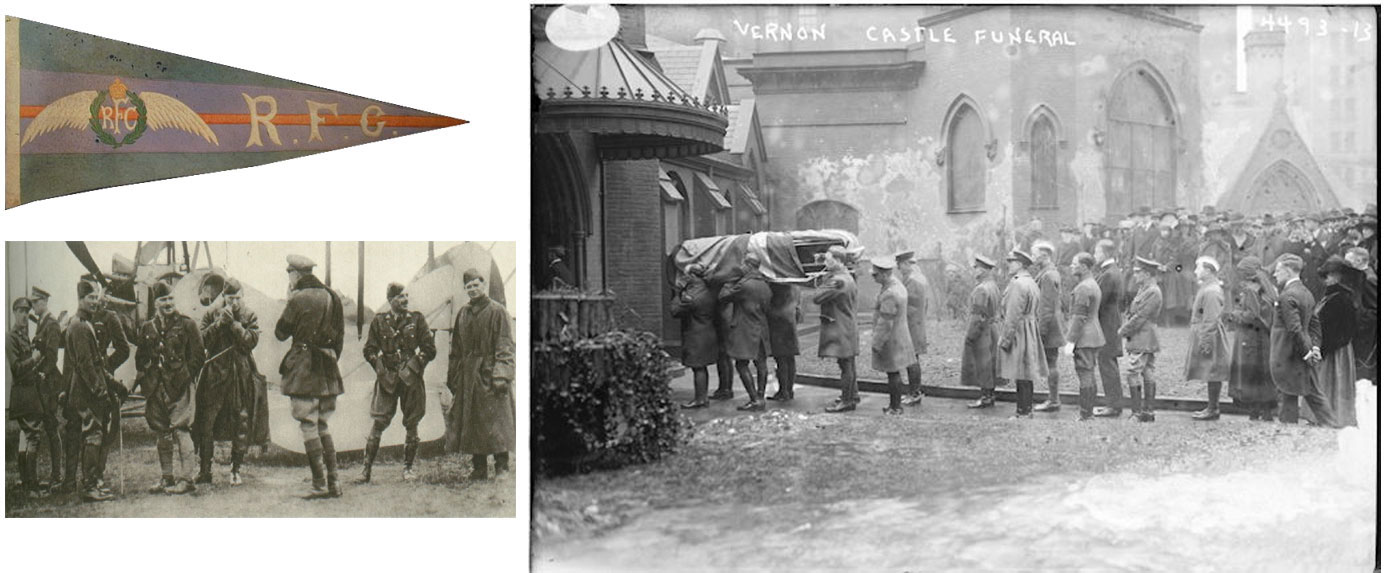
FORT WORTH + WORLD WAR II
During World War II, a Quartermaster Depot was built. Construction of the $10 million Quartermaster Depot began in the winter of 1941–42 and included extension of lines of the Missouri, Kansas and Texas and the Santa Fe railroads to the site. The Quartermaster Depot building would later become The Federal Records Center - and now the site of the National Archives at Fort Worth on John Burgess Drive - named after Fort Worth resident and US Army Private First Class John Lewis Burgess who enlisted in 1940, served overseas for 34 months, fought in the North African Campaign, in Sicily, and died on D-Day during the invasion of Normandy.

At the same time as the construction of the Quartermaster Depot, the US also built the Marine Corps Air Station (Eagle Mountain Lake). It would also be the first time that U.S. Marines would have a Fort Worth Marine Air Base and be stationed here in Fort Worth (Eagle Mountain Marine Corps Air Station).
A third Air Field was built - the Fort Worth Army Air Field (that would later become Carswell and today NAS JRB). Fort Worth was chosen as the site for these three major military supply and air strips because of Fort Worth's proximity to area army camps, large packing plants, highways, and railroad lines. Fort Worth's "Tarrant Field" would also play a key role in the war becoming a heavy-bomber training school.

Here is 142nd Infantry Regiment, 36th Division at Camp Bowie in 1941:


The Army Air Forces Combat Crew School, later redesignated Army Air Forces Pilot School, took graduates of Training Command's advanced-pilot training schools and trained them on flying the B-24 Liberator.
US MARINE CORPS AIR STATION EAGLE MOUNTAIN LAKE
In 1942, close to 3,000 acres of former ranch land was purchased on the eastern shore of Eagle Mountain Lake so the Marine Corps could set up glider operations. Construction of the base began on 24 July 1942. Marine Glider Group 71 (MLG-71) and Marine Glider Squadron 711 (VML-711) arrived at the base in November 1942 and the station was officially commissioned on 1 December 1942. Marine Corps Air Station Eagle Mountain Lake (MCAS Eagle Mountain Lake) was a US Marine Corps air station established in Fort Worth during World War II. It was originally used as the home of the Marine Corps PBY-5A Catalina Amphibian Glider program - with the glider aircraft built by Fort Worth's Consolidated at Carswell Air Force Base (which is now Lockheed Martin at Naval Air Station JRB). Following the glider program, which ended in 1943, the station became home to the newly created Marine Night Fighting Squadrons.

In April 1944 the air station reverted back to Marine Corps control by the authorization of CNO Dispatch 31TWX1715. Marine Aircraft Group 33 (MAG-33) arrived from Bogue Field, North Carolina and then later left for San Diego. In August 1944, Marine Aircraft Group 93 (MAG-93) arrived from Marine Corps Air Station Cherry Point and remained until November 1944. In December 1944 the field became the home of Marine Aircraft Group 53 which was the Marine Corps' first night fighter group.

From then on the base was used primarily for night fighter training. Two common night fighters that operated from the field were the Grumman F6F Hellcat and F7F Tigercat.

After the war, the air station went into caretaker status in December 1946 and became an "Outlying Landing Field" of Naval Air Station Dallas (Grand Prairie) and also used by various branches of the military. From 1953 to at least 1955 it was listed on maps as "Eagle Mountain Lake National Guard Base".
It is very likely the most decorated soldier of WWII, Captain Audie Murphy of the Texas National Guard, visited the Fort Worth base and airstrip. This WWII hero is honored with a star on the Texas Trail of Fame in the Fort Worth Stockyards. There is also a Fort Worth Association of the US Army Audie Murphy Chapter.

In 1959, the severely deteriorated buildings were used in a science fiction film entitled "Beyond the Time Barrier", in which the protagonist, an Air Force test pilot, travels into the future on a supersonic airplane and returns to find that the air base from which he took off is in ruins.

FORT WORTH + NAVY DRONES
After the Marine Corps cancelled its glider program in 1943, The Eagle Mountain Marine Corps Air Station would then became the Navy's Strategic Tasks Air Group 2 used the airfield to test newly developed remote control aircraft before relocating to Traverse City, Michigan in 1944. Unmanned assault drones remained an unproven concept in the minds of military planners through major allied testing and advances in 1944. Utilization was limited to a 4-drone attack on a beached Japanese merchant ship in the Russell Islands followed by expenditure of 46 drones in the northern Solomon Islands. Two hits and two near-misses were scored on the stationary ship. Several of the later drones failed to reach their targets, but most were effective.

KENNETH COPELAND PURCHASES THE AIR FIELD
By 1973, maps depicted Eagle Mountain Lake as an abandoned airfield. In the early 1980s, the property was purchased by televangelist Kenneth Copeland, and as you can see on the map below right, it is now home to a substantial fleet, small fleet but expensive, with the multiple aircraft listed below right all owned by Kenneth Copeland Ministries, including WWI and WWII era aircraft. Kenneth Copeland is an avid pilot, and his pride and joy is a $20 million Cessna Citation jet - the fastest private jet money can buy. Note: You can right-click and view-image to see a larger version of the image.
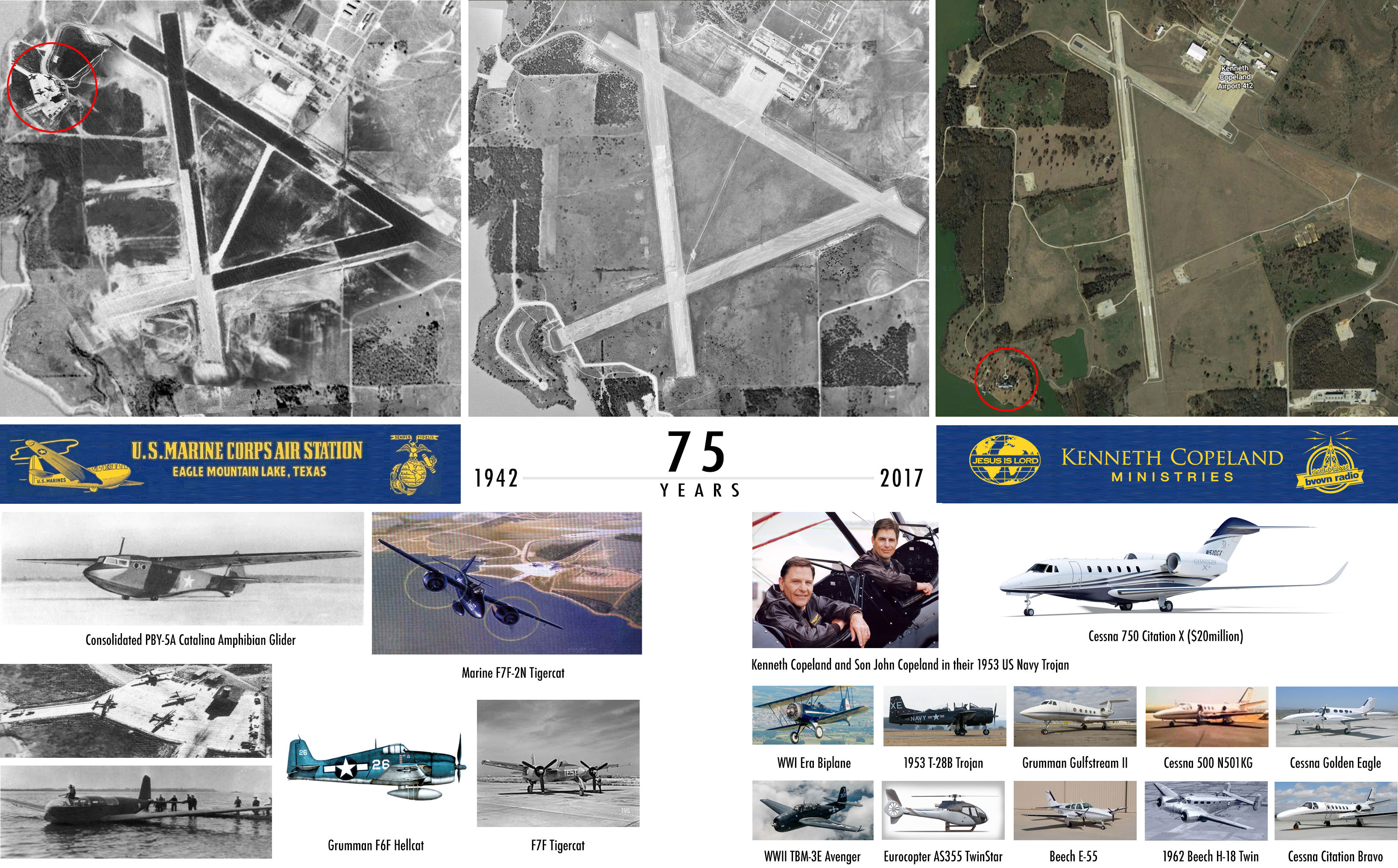
The water glider can be seen on the water in the above photo - and several grouped by the water in the photo just above it - which is a closeup of what is within the red circle on the above aerial map. The painting above shows the Marine F7F-2N Tigercat actually flying out of the same spot of the map. In addition to the Consolidated PBY-5A Catalina Amphibian Glider and the Marine F7F-2N Tigercat, is the Grumman F6F Hellcat that could also take off and land on the water.
KENNETH COPELAND MAY BE PREPARING FOR THE NEXT HELL'S HALF ACRE
The red circle on today's map above is Kenneth Copeland's 18,280 square foot multi-million dollar lakeside parsonage built right on the same property as the airstrip. He also has his own electrical plant (using gas from his land), multiple water wells, a purification plant, and his own sewage plant built on his property.
All of this plus three (3) fighter planes, seven (7) jets, and one (1) helicopter. So what is he planning for? All out war? Tribulation?

Maybe he is simply preparing for the battle against outlaws of the next Hell's Half Acre - or the gangsters of the next Thunder Road.
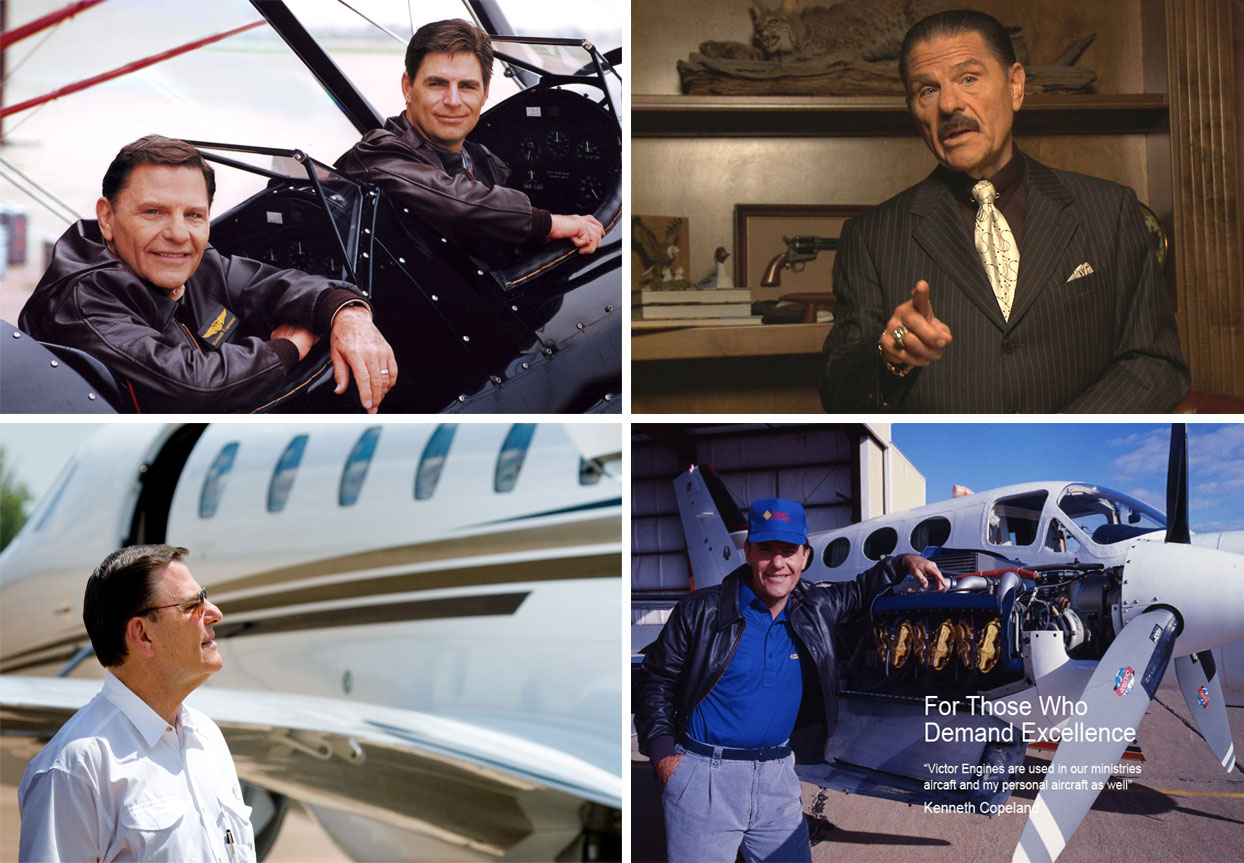
Reverend Copeland now has 10 airplanes plus a helicopter. He says he uses all of these aircraft for relief missions and conventions to spread the word of God. Hey, that's a lot of aircraft for anyone, let alone a church.

So why does Kenneth Copeland have an entire fleet of jets and fighter planes? Maybe he intends on turning his air strip back into a military air wing to fly attack missions - just in case Hell's Half Acre or Thunder Road tries to make a comeback in Fort Worth.
Back in the early 1900s, Fort Worth had Reverand J. Norris with his guns - but now we have Reverend Copeland with combat fighter planes.
FORT WORTH + PRESIDENT FRANKLIN D. ROOSEVELT
On 16 June 1941, President Franklin D. Roosevelt approved a $1.75 million dollar budget to construct an airfield next to the Consolidated manufacturing plant. The Army wanted to have the airfield ready quickly before the plant was put into production and construction of the "Lake Worth Bomber Plant Airport" began almost immediately. In 29 July 1942, "Tarrant Field" was renamed to "Fort Worth Army Field", and President Roosevelt visited Fort Worth Army Field later that year to inspect the new B-24 Bombers.


The school was initially equipped with B-24Ds that were assembled across the runway at Consolidated Vultee - and later it was upgraded to B-24Es. In November 1945, jurisdiction of Fort Worth AAF was transferred to Second Air Force, which established its 17th Bombardment Operational Training Wing at the base, equipped with B-29A Superfotresses.
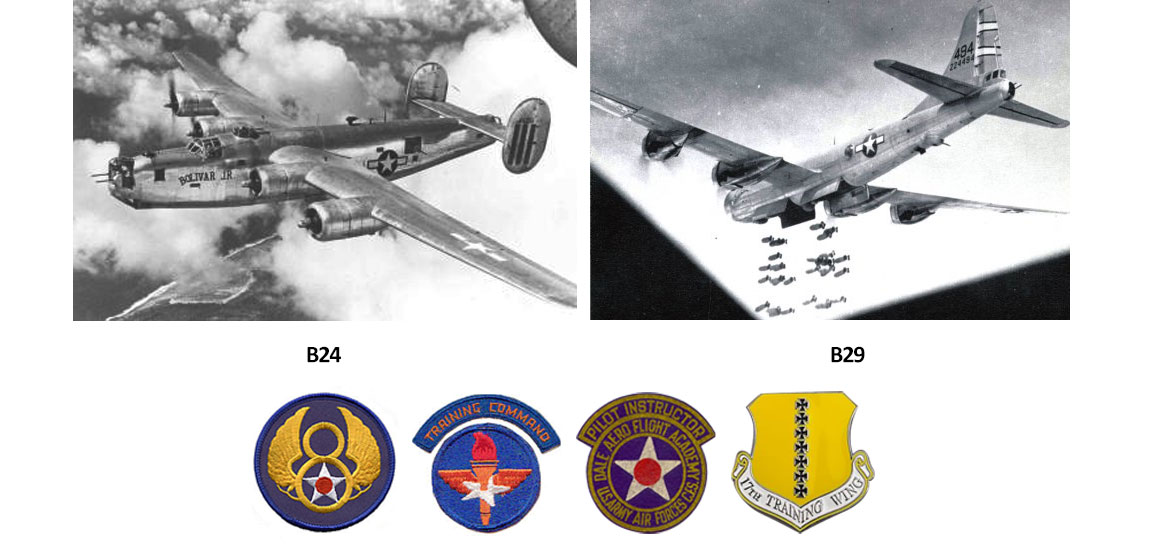
Here is the 11th Armored Replacement Battalion in 1942 at Fort Knox - upon their immediate return from Camp Bowie where they did their training.

In 1946, the Air Force decided to keep Fort Worth as a permanent airfield and constructed an 8,200 ft North-South extra heavy-duty runway for future use.
Fort Worth Army Air Field was then assigned to the newly formed Strategic Air Command in March 1946, and on 1 October 1946, the 7th Bombardment Group was activated. With its B-29s, the group prepared its people for any combat eventuality that might arise, flying simulated bombing missions over various cities in and around Fort Worth. On 5 July 1947, a flight of eight B-29s of the 492nd Bomb Squadron deployed from Fort Worth AAF to Yokota AB, Japan.
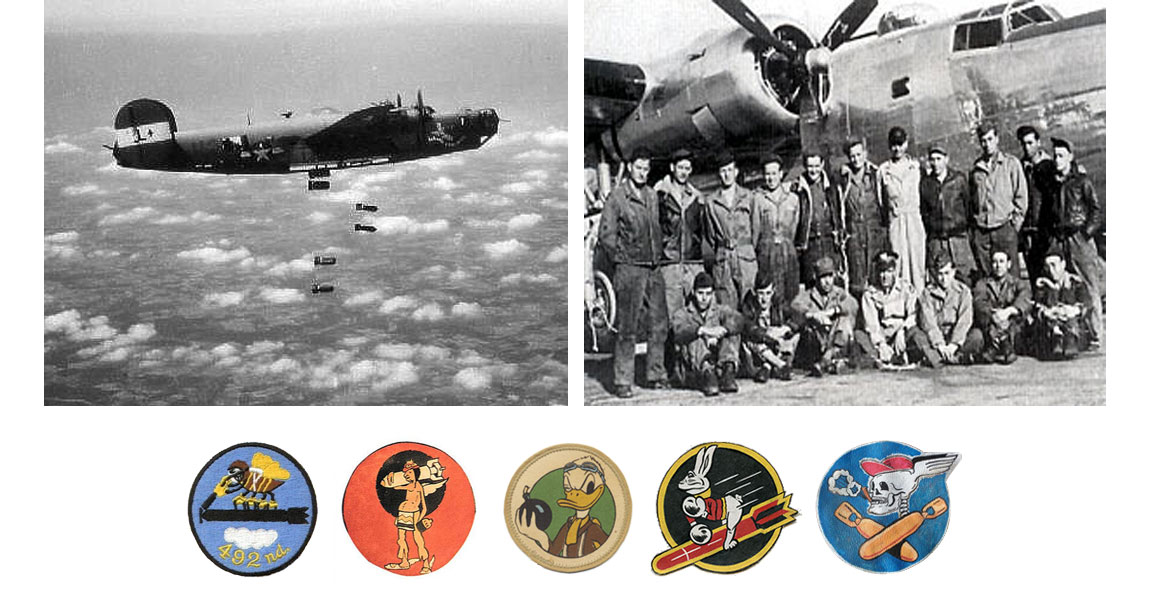
Upon return to the states, the detachment received orders to redeploy to Fort Worth AAF via Washington, D.C. The aircraft left Yokota AB on 2 August. The bombers flew a low-level flight between The Pentagon and Washington Monument in the Capital on 3 August. Completing this aerial demonstration, they headed for Fort Worth, landing 31 hours after launch from Japan and covering 7,086 miles.
On 12 September, the group deployed 30 B-29s to Giebelstadt Army Airfield, near Würzburg, West Germany. This flight was the largest bomber formation flown from Fort Worth AAF overseas to date, landing in Germany on 13 September. During their ten-day stay, the group bombers participated in training operations over Europe, as well as a show-of-force display by the United States in the early part of the Cold War with the Soviet Union. The flight redeployed from Germany on 23 September.
CAMP BOWIE MOVES TO BROWNWOOD, TEXAS
While the new airstrips and air units remained in Fort Worth, the War Department announced on 19 September 1940 that Camp Bowie would be moved to Brownwood - about an 130 miles southwest of Fort Worth. Work began at the campsite on 27 September 1940. In 1943, the first German prisoners of war arrived. Most of the prisoners were members of Rommell’s Afrika Corps. The camp would be referred to as the "Camp Bowie Internment Camp" and would end up holding 2,724 German prisoners. But Camp Bowie in Brownwood wouldn't last too long - On 1 August 1946, the War Department notified Texas members of Congress that the Camp had been declared "surplus" and the Civilian War Assets Administration was to take charge and they began the distribution of the land and buildings. There were actually a total of nearly 50,000 German prisoners of war held in dozens of camps across Texas. History reports that the majority of prisoners were "kind and well behaved" and they came to better understand and love America, and at the end of the war, many men became day laborers for the farmers and ranchers in Central Texas. Note: Central Texas has long been a German immigrant destination since the 1840s with such settlements as Fredericksburg and New Braunfels.

Today, Camp Bowie Boulevard is made up of three distinct sections: 1) "Camp Bowie On-the-Bricks" starts just West of West 7th at University and ends at Interstate 30, 2) "Camp Bowie Ridglea" starts after Interstate 30 and runs to 183, and 3) "Camp Bowie West" represents the remaining strip.

FORT WORTH + US NAVY HELIUM PLANT
Did you know that the very first US helium gas plant was built in 1917 by the US Navy, right here in Fort Worth? Helium blimps (aka "Airships" and "Diligible Balloon") began appearing over Fort Worth in the early 1900's. That's right, Fort Worth's "SECRET WWI helium production plant" was right here in our city - secret to the world - but NOT secret to the residents and military in Fort Worth. The U.S. military was interested in the use of helium as a lifting gas in lighter-than-air craft as a potential replacement for flammable hydrogen gas. Before helium in airships there was hydrogen. The first hydrogen balloon appeared in 1783 in Europe.

The US Army used hydrogen-filled balloons for observation purposes during the Civil War, and both the US Army and US Navy continued to experiment with hydrogen-filled balloons up until the US joined the conflict in Europe.
Did Fort Worth discover helium? No. For some time, helium was believed to exist only in the Sun - until 1882 when an Italian physicist detected helium on Earth when analyzing lava from Mount Vesuvius after it erupted in that year. France and Great Britain had tested helium airships as early as the lavery late 1800s. Interestingly, H. G. Wells' book "The War in the Air" in 1908 described the obliteration of entire fleets and cities by airship attack.
The biggest problem for Europe was the fact that helium was not a readily available resource. So where was the largest resource of helium gas?
FORT WORTH BASIN OF BARNETT SHALE

That's right, directly under our city. Fort Worth was sitting directly on top of the largest source of helium in the world.
Oil companies in Texas figured out how to extract helium from natural gas, specifically in the Fort Worth Basin's Barnett Shale, the largest resource for natural gas. So it was no wonder that Fort Worth became the preferred location for the very first US helium production plant. The helium product plant was built just north of downtown Fort Worth at the present-day intersection of Blue Mound Road and Meacham Boulevard, just east of Meachum Airport.
FORT WORTH + MEACHUM INTERNATIONAL AIRPORT
Originally called the "Fort Worth Airport" established in 1914 to serve the United States Army Airways, it was later subleased to the Fort Worth Chamber of Commerce and renamed "Meachum Field" as a municipal airport in 1926. Originally composed of just 100 acres, the early days of the facility saw aircraft operating from runways composed of dirt and sod. The airport would then be named after former Fort Worth Mayor Henry C. Meacham. Charles Lindberg landed there in 1927.

By the early 1950s, Meachum Field was served by American and Braniff Airlines (both headquartered in Tarrant County), and Delta Airlines on 350 acres and served as direct competition to Dallas Love Field. In 1953, all airlines moved over to the "Amon Carter Field" (later named Greater Southwest International Airport"), located on the southeast corner of highway 183 and 360. Note: With the opening of DFW Airport in 1974, airlines moved again from Amon Carter Field and Love Field. Meachum Field has had continued use throughout the years. Since 1953 Meacham Airport has been used for corporate aircraft, commuter flights, and student pilot training. It was renamed in 1985 to "Fort Worth Meacham Airport" and in 1995 to "Fort Worth Meacham International Airport".
Also note that Henry C. Meachum also owned the Meacham Department Store in Fort Worth - and in 1926, as Mayor, Meacham had an ongoing public fued with Reverend J. Frank Norris of the First Baptist Church which would end in the Reverend shooting and killing a man who was sent to kill him.
FORT WORTH ARMY AIR FIELD
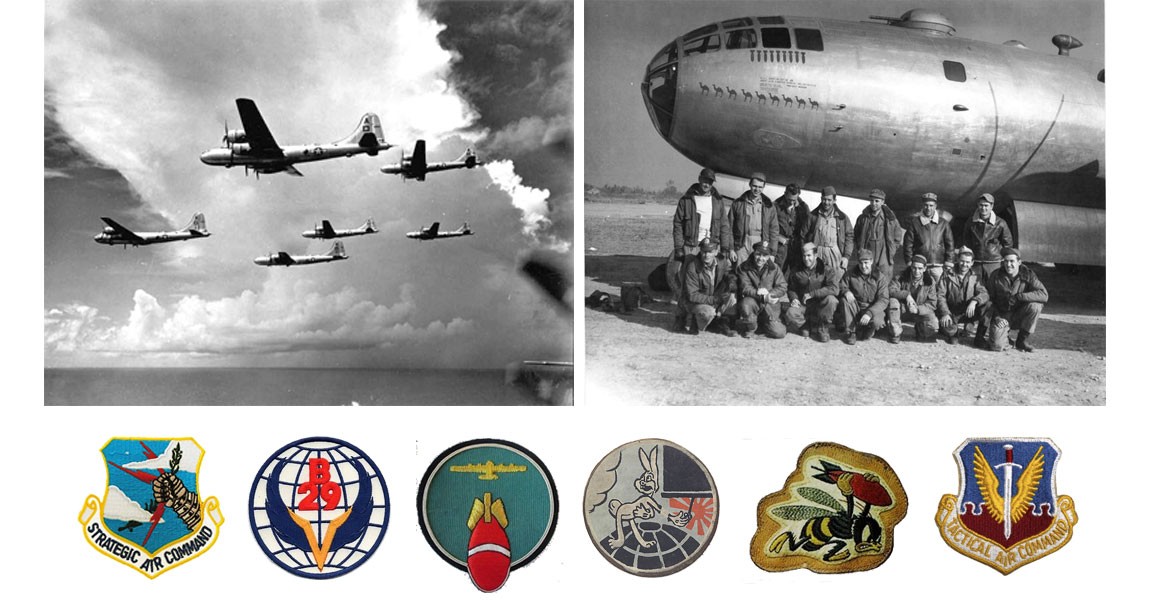
In 1947, shortly after the United States Air Force was established as a separate branch of the United States military, the 7th was selected as one of the "Test Wings" to evaluate the new organization, and on 17 November 1947 the 7th Bombardment "Wing" was established. The test was successful and the wing was made permanent on 1 August 1948. As part of the new organization both the 7th and 11th Bombardment Groups became its operational components.
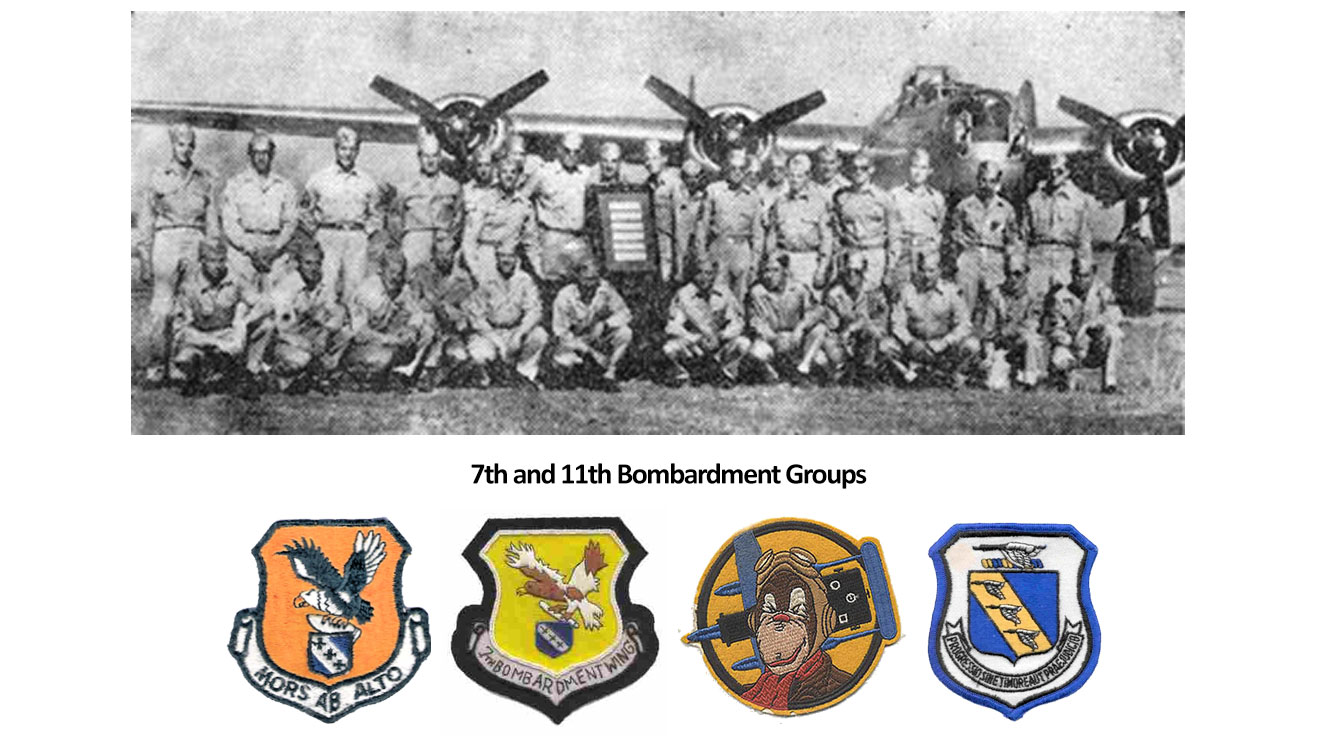
Since 1942, the XB-36 Peacemaker long range bomber had been under development by Consolidated, and work on it was shifted from Consolidated's San Diego, California plant to its government-leased plant in Fort Worth. By 1947 the initial production version B-36A was ready, and in June 1948 the first Convair B-36A Peacemaker was delivered to the Air Force. The first B-36A was designated the "City of Fort Worth" (AF Serial No. 44-92015) and was assigned to the 492d Bomb Squadron.

B-36s continued to roll out from the production plant throughout 1948 while being assigned to the 7th Bomb Group. Today, the City of Fort Worth and Meachum Airport provided space for the B-36 Peacemaker Museum. and houses the massive B36 among many other historic aircraft.
RENAMING OF THE AIR BASE
In 1948, the Fort Worth base's name was changed to memorialize native son and Medal of Honor winner Major Horace S. Carswell, Jr. who gave his life while attempting to crash land his crippled B-24 over China. He was a graduate of Northside High School and graduated of TCU before joining the Air Force.

When the Army Air Field was renamed Carswell Air Force Base, it became the headquarters of the 19th Air Division in 1951. B-52 bombers of the 7th Bombardment Wing — a crucial piece of the U.S. nuclear arsenal during the Cold War and of Strategic Air Command — soon called Fort Worth home as well.

In January 1951, the 7th Bombardment Group took part in a special training mission to the United Kingdom. The purpose of the mission was to evaluate the updated B-36D under simulated war-plan conditions and further evaluate the equivalent airspeed and compression tactics for heavy bombardment aircraft. On 16 February 1951, the 11th Bombardment Wing was activated, and the 11th Bombardment Group was assigned to it. The 19th Air Division was organized the same day at Carswell. With this move, the division assumed responsibility over both the 7th and 11th Wings at Carswell. broOn the same date, all other flying squadrons reassigned directly to the 7th Bombardment Wing as part of the Tri-Deputate organization plan adopted by the wing.

GENERAL MACARTHUR ARRIVES AT CARSWELL
General Douglas MacArthur arrives at Carswell in 1951 - and would later ride in a parade in downtown Fort Worth.

On 10 December 1957, the 98th Bombardment Squadron was detached from the wing and assigned to the newly activated 4123d Strategic Wing at Carswell. This would become the first Boeing B-52 Stratofortress unit at Carswell. The 7th Bomb Wing officially became a B-52 organization with the adoption of manning documents and equipping authorizations on 1 February 1958. On 19 February 1958, the 4123d Strategic Wing took possession of the first Boeing B-52 Stratofortress on Carswell. At the arrival ceremony on base, the bomber was named "The City of Fort Worth." It was subsequently assigned to the 98th Bombardment Squadron of the wing.

The establishment of Consolidated-Vultee’s aircraft plant was a milestone for Fort Worth when it was built on the shore of Lake Worth alongside the airfield. During the war, the mile-long plant produced more than 3,000 B-24 Liberator bombers, with a peak employment of 32,000. The facility would change hands over the years to various defense contractors — Convair, General Dynamics and, currently, Lockheed Martin — and produce some of the world’s most important aircraft, including the B-36 Peacemaker and the F-16 Fighting Falcon. In addition, the man-made lake, built in 1914, adjacent to the military base and military contractors was renamed Lake Worth in honor of General William Worth.

FORT WORTH + KOREAN WAR
From 1950 to 1953, Fort Worth played a key role in the Korean War with several units coming out of Carswell in Fort Worth, including Air Force's 7th Air Police Squadron and the 8th Air Force.

A Fort Worth resident, Charles F. Pendleton, joined the US Army in 1951 and served in the Korean War with 15th Infantry Regiment, 3d Infantry Division. He was killed in action on 17 July 1953 and posthumously received the Medal of Honor.

Another Fort Worth native, George H. O'Brien Jr. was also a Medal of Honor recipient who was serving as a second lieutenant with Company H of the 3rd Battalion 7th Marines on 27 October 1952. On that day, he spearheaded the capture of an enemy-held hill while wounded by enemy fire. For this action, he was awarded the Medal of Honor by President Dwight D. Eisenhower during a White House ceremony on 27 October 1953 - exactly one year to the day after the action for which he was cited. He was promoted to major in 1963. In addition to the Medal of Honor, Major O'Brien held the Purple Heart with Gold Star in lieu of a second award, the Korean Service Medal with two bronze stars, and the United Nations Service Medal.

FORT WORTH + JFK
Many are not aware that John F. Kennedy Kennedy served as a lieutenant in the US Navy during World War II from 1941 to 1945. He served in the Solomon Islands in the South Pacific and earned a Purple Heart and the Navy and Marine Corps Medal. JFK could have skipped over Fort Worth and flown straight to Dallas - but he loved the military and wanted to visit the famous Carswell Air Force Base.
On November 21, 1963, President John F. Kennedy arrives on Air Force One at Carswell Air Force Base. President and Mrs. Kennedy shared a limousine with Texas Governor John Connally (who had served as Secretary of the Navy under President Kennedy). Connolly served as an officer in the US Navy during WWI and was awarded the Bronze Star and the Legion of Merit.
At 11:00, the motorcade turned slowly north onto Main Street moving towards the Tarrant County Courthouse. The street was lined with a cheering, waving populace. The motorcade turned west on Belknap, north onto Jacksboro Highway, then west again along River Oaks Boulevard where school children waved banners. Air Force One awaited their arrival at Carswell Air Force Base. Air Force Two was the first to depart. Thanking Fort Worth law enforcement officers and shaking hands with onlookers, the President turned and waved to his Fort Worth supporters as he and Jackie boarded Air Force One for the 13-minute flight to Dallas Love Field.

FORT WORTH + VIETNAM
On 13 April 1965, the 7th Bomb Wing deployed its forces to Andersen Air Force Base, Guam to bomb the Socialist Republic of Vietnam. Most of the wing's bombers and tankers, along with aircrews and some support personnel, were deployed. At Andersen, the wing flew more than 1,300 missions over Vietnam, and returned to Carswell in December 1965. The B-52 effort was concentrated primarily against suspected Viet Cong targets in South Vietnam, but the Ho Chi Min Trail and targets in Laos were also hit. During the relief of Khe Sanh, unbroken waves of six aircraft, attacking every three hours, dropped bombs as close as 900 feet (270 m) from friendly lines. Cambodia was increasingly bombed by B-52s from March 1969 onward.

Robert David Law was born in Fort Worth and served in the US Army during Vietnam. He served as a specialist four in Company I, 75th Ranger Infantry Regiment (Airborne), 1st Infantry Division and was killed in action on 22 February 1969 and is a recipient of the Medal of Honor.

Rotational deployments from Carswell to Guam continued, and also to U-Tapao Royal Thai Navy Airfield, Thailand continued on a reduced scale until 1975. In the 1980s, the 7th received several new weapons systems, including modified B-52H aircraft. In 1983, B-52 crews began training with a new weapon system, the SRAM (Short Range Attack Missile) and later, in 1985, the ALCM (Air Launched Cruise Missile). Also, the wing flew numerous atmospheric sampling missions during 1986 and 1987 in response to the Chernobyl nuclear reactor accident; four B-52H aircraft (s/n 60-0024, 60-0033, 60-0051 and 60-0052) were modified to carry atmospheric sampling pods code-named "Giant Fish." By 1984, Carswell was the largest unit of its kind in the Strategic Air Command.
FORT WORTH + DESERT STORM
On 2 October 1990, the President of Iraq Saddam Hussien invaded the country of Kuwait. At that time, the 14th Marines and Marine Air Group MAG 41 (NAS Dallas) and all the Air Force Bombardment and Fighter Wings (Carswell) deployed to the Middle East 1990-1991.
Active in Desert Shield, Desert Storm, and the Cease Fire Campaign, Carswell housed the largest B-52 Wing and used B-52Hs and KC-135s in the war. Virtually every wing unit at Carswell Air Force Base deployed personnel with over 800 airmen.

14th Marines deployed communication, radar, and engineers to Headquarters Battery in support of the combat units (Sergeant Bret Stout) of 5/10 2nd Marine Division M109 Self-Propelled Howitzers out of Camp LeJeune, North Carolina. Bret Stout's howitzer platoon, with an Army Tiger Brigade platoon attached for direct-fire support, focused in on and attacked Iraqi Republican Guard positions in Kuwait and Southern Iraq. Marine Aircraft Group 41 (MAG-41), also out of NAS Dallas, deployed to Okinawa in support of the war.

Nearly 700,000 U.S. troops were deployed to the Persian Gulf from across the country, and after an overwhelming victory, the Marines of 14th and MAG41 and Air Force Airmen returned to Texas.
CARSWELL BECOMES NAVAL AIR STATION JRB
In 1993 the Air Force Reserve's 301st Fighter Wing assumed base responsibilities and the base name was changed to Carswell Air Reserve Center - but less than one year later, Naval Air Station Dallas (Grand Prairie) was relocated to Carswell and was repurposed as the Naval Air Station Joint Reserve Base Fort Worth (but also retains the Carswell Field name).

In addition to the Air Force, Army and Navy units, there are six Marine Corps units - MAG-41, 4th Marine Aircraft Wing, HQ Battery 14th Marines, VMFA 112, VMGR 234, and MACS 24. In addition, the 8th Marine Corps Recruiting District is also based at NAS JRB. Operational control of the base changed hands from the Air Force to the Navy in 1998.
FORT WORTH + IRAQ + AFGHANISTAN
Fort Worth's Naval Air Station Joint Reserve Base has played an important role in the wars of Iraq (Operation Iraqi Freedom) and Afghanistan (Operation Enduring Freedom) and included units from all five branches - Army, Texas National Guard, Navy, Air Force, and Marine Corps. Among the units deployed included units that were deployed and attached to a number of different units, including: the 301st Fighter Wing, 49th Armored Division, Texas Army National Guard, 36th Infantry Division, 131st Field Artillery, 1st Marine Division, 1st Infantry Division, 2nd Infantry Division, 25th Infantry Division Fires Brigade, 56th BCT, 3/133 FA, 2/142 INF, 3rd Battalion, 141st Infantry Regiment, 72nd Brigade, 504th Infantry Regiment, 82nd Airborne Division, 1st Squadron, 124th Calvary Regiment, 36th Infantry including 1-112 AR, 2-112th AR, 3rd Mech, and C Battery 2-131 FA (MLRS), 144th Infantry Regiment mobilized as Task Force Panther, 56th IBCT, Bravo Troop 3-124 Cav, C Battery 4-133, 136th Military Police Battalion, 1st Battalion Airborne, 143rd Infantry Regiment mobilized as Task Force Walker, 648th Maneuver Enhancement Brigade (MEB), 3rd Battalion C & D Company 144th Infantry Regiment, 56th BCT, among many others.

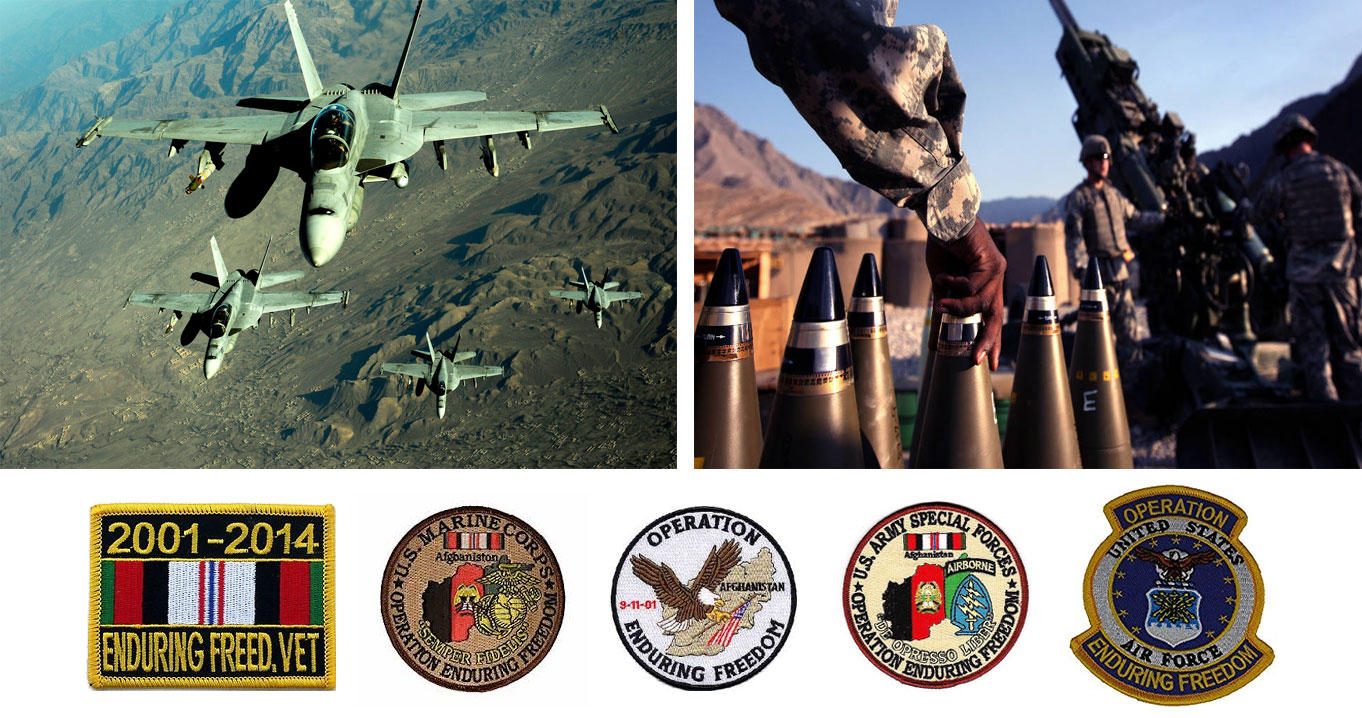
WAR ON TERROR
Naval Air Station JRB plays a very significant role in the War on Terror. Air Force Secretary Deborah Lee James recently released a statement stating the Air Force has selected Naval Air Station JRB Fort Worth as the preferred location for the first reserve F-35 unit. The statement suggested that the base could be some of the first to receive aircraft. “We selected the Air Force Reserve unit in Fort Worth because it is the location that meets all of the necessary training requirements at the lowest cost,” said Air Force Secretary James in a 12 January 2017 release.

“Additionally, the location will provide mission synergy and access to an experienced workforce for recruiting as a result of its proximity to the F-35 manufacturing plant,” which also is based in Fort Worth. – Air Force Magazine
On 28 June 2016, State Comptroller Glenn Hegar was in Fort Worth touting the economic impact of Naval Air Station Joint Reserve Base Fort Worth, which he says contributes $6.6 billion to the economy last year. "The economic impact is significant," Hegar said during a news conference at the Fort Worth Club. "If you live right next to the naval base, you understand it. If you're a little bit farther away in Fort Worth, you know it's here but you probably don't appreciate it."

Statewide, Hegar said 15 military installations contribute $136.4 billion in total output and contribute $81.3 billion to the gross domestic product. Those military installations also employ 804,268 people "in some capacity." The comptroller's office said the NAS Fort Worth provides 17,466 direct jobs and 47,256 jobs when adding indirect employment, such as someone who does business with the base. Lockheed Martin, which has 13,700 employees and a $1.4 billion payroll, is included in those numbers.

At NAS Fort Worth, there are 9,723 employees, including 5,957 National Guard and reserve personnel, 1,886 active duty and 1,880 civilians.
With Lockheed Martin and Bell Helicopter both headquartered in Fort Worth, our city will remain at the forefront on the War on Terror - in Afghanistan, Iraq, Syria, North Korea - and other countries who want to test the resolve of our country. As President Trump has proven in the early part of 2017, and as Vice President Pence recently stated, "The United States of America will always seek peace first under President Trump, but the shield stands guard and the sword stands ready." Pence continued, "Those who would challenge our resolve or readiness should know, we will defeat any attack and meet any use of conventional or nuclear weapons with an overwhelming and effective American response".
That is Fort Worth. We have stood guard for our country and have always been ready to fight. This has been proven from the very beginning as Fort Worth has played a significant role in every war - from swords to F35s.

FORT WORTH's PROUD MILITARY HISTORY
Fort Worth has had a long and rich military history - from just after the Mexican-American War, and from the Civil War to today's wars in the Middle East. Fort Worth is very proud of this heritage and has always honored our Veterans.

US NAVY'S LCS-3 USS FORT WORTH
USS Fort Worth (LCS-3) is a Freedom-class Littoral Combat Ship of the United States Navy. She is the first ship to be named after Fort Worth, Texas and the ship's name was announced on 6 March 2009. The ship was built at Lockheed-Martin and was launched on 4 December 2010. The Navy's USS Fort Worth was commissioned at Galveston, Texas on 22 September 2012 and set sail on a 16-month deployment in the Fall of 2014. Noteworthy is the fact that Bret Stout led the UI design for the billeting system for the entire US Navy's LCS fleet.

NAVAL AIR STATION JOINT RESERVE BASE FORT WORTH TODAY

You can find out more about Naval Air Station Joint Reserve Base by going to:
Naval Air Station JRB Fort Worth or Wikipedia

The military remains a significant part of Fort Worth to this day. And Carswell Airfield and NAS JRB still connects Fort Worth to its military heritage in a time of rapid diversification and growth.
Whew! The military history of Fort Worth went much deeper than I thought before I started compiling and writing this page. And there was a bunch I left out. My perception of Fort Worth has definitely changed.
IT'S TIME TO RETHINK FORT WORTH
Now the next time you see or hear a military aircraft over your head, or you see a street or city sign, or you see the railroad tracks everywhere throughout the city, think about the long and rich military history of Fort Worth. Yes, it is time to rethink Fort Worth.

ABOUT THE AUTHOR BRET STOUT
Bret Stout has known about Carswell Air Force Base since he flew from Carswell to Andrews Air Force Base in 1988. Bret lived in Dallas for over 20 years and his wife was born and raised in Fort Worth. After ad agency tenures in Dallas, Houston, and Austin, Bret's wife encourage him to consider a move to Fort Worth, the place of her birth, and friends and family. Bret's military history is also connected directly to Fort Worth. Back in 1986, Bret joined the Marine Corps Reserve for several reasons: 1) His father had served honorably in the Marine Corps, 2) He wanted to experience the hard work and pride of the Corps, and 3) It would be an excellent way to get target audience information for a military campaign he was assigned. It was suppose to be a grueling three and a half months in bootcamp, three months of MOS school, and then once a month and two weeks a year - but it ended up being much different than expected. He was activated to war four years later and served a total of eight years in the Marine Corps.
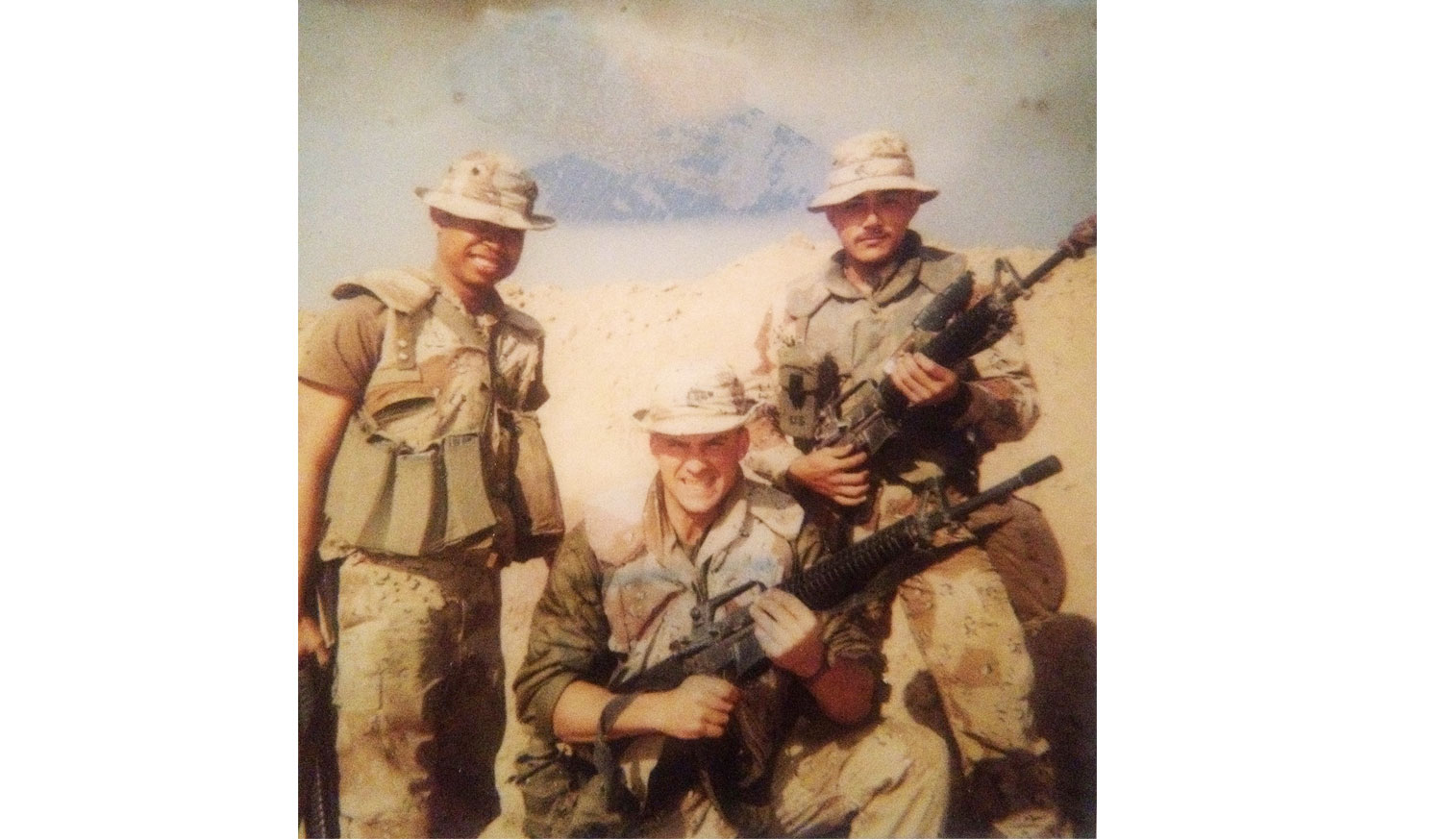
He completed his U.S. Marine Corps Boot Camp training at MCRD San Diego and served as a Platoon Squad Leader graduating meritoriously-ranked with Honors. He went to MOS school in Aberdeen, Maryland. He served with 4th Marine Maintenance Battalion, and conducted extended training in Twenty-Nine Palms, California and Camp LeJeune, North Carolina. Bret was transferred to MAG-41 and would be going to aircraft maintenance school when he was informed he could not transfer from Waco 'Division' to Dallas 'Wing' - but could transfer to Dallas 'Division' - and if not assigned a new MOS in one year could then transfer to MAG-41. This is how he ended up at Headquarters Battery 14th Marines. But during that one year period he would be activated to the Middle East and served in combat with 5th Battalion, 10th Marines, 2nd Marine Division as a Sergeant in charge of a M109 Self-Propelled Howitzer squad against Saddam Hussein and the Iraqi Republican Guard to regain control of Kuwait.

Bret Stout is a Combat-Decorated United States Marine Corps Veteran with eight ribbons (five medals).

Since the war, his military experience has been highly valuable to VA and DoD with his brand and UI strategy work for the Health Informatics Initiative (hi2), the next-generation health management platform that is web-based and population-driven, branding for VA's Office of Patient-Centered Care, UI strategy and design for the U.S. Navy's billeting system on the LCS War Ship Fleet, and as an elected board member of VA's Veteran Experience Committee.
PROFESSIONALISM AND INTEGRITY
Note: You might be thinking, "What does the military and branding have to do with each other?" – of course it applies when you're doing branding and campaign work for the government and military because you understand the target audience demographics – but the main reason the military experience is included is to show that Bret Stout has a high level of honor, professionalism, and integrity.
And this military experience connects directly to the legacy of Fort Worth.
FORT WORTH'S VETERAN GROUPS
There are many military Veteran groups here in Fort Worth that are making positive impacts in people's lives. While there are Veteran groups of every branch, Bret Stout is naturally focused mainly on Fort Worth's Marine Corps Veteran Groups - but will add other organizations for other branches on an ongoing basis.

CLICK ON THE LOGOS BELOW TO FIND OUT MORE
A Facebook non-profit based out of Fort Worth and over 1,100 member strong, DFW Devildogs is organized by four (4) local Marines, and is truly a group of Marines Supporting Marines.

Another Facebook non-profit group based out of Fort Worth with over 1700 local members and growing (since January 2017), Devil Dog Nation was also formed and organized by four (4) local Marines. This is the local group:

And the National coverage has already grown to 20 Chapters across the U.S. Devildog Nation's non-profit mission is to never leave any brother behind and serves as a support group to prevent Veteran suicide and homelessness:

Cowtown Warriors of Fort Worth was founded by Marines, but is now represented by all military branches. It is led by Jeremy Spann, TCU MBA, served in the US Marine Corps, and former Fort Worth Police Detective. Their mission is to serve and honor our Wounded North Texas Veterans. Cowtown Warriors is also a non-profit and they host the Annual Cowtown Warriors Ball where they raise a significant amount of money for disabled Fort Worth Veterans. Members of the non-profit board include many Fort Worth Police Officers and Detectives who are also Fort Worth military Veterans:


We have spoken a lot about the Naval Air Station Joint Reserve Base Fort Worth and here is the direct link:

The Fort Worth Aviation Museum has an amazing collection of aircraft - many that were once active at Carswell Air Force Base - including an F-14D Tomcat, T-33A Shooting Star, O-1 Bird Dog, F/A-18, F-111E Advark, CH-53 Sea Stallion, A-12 Avenger II, RF-8 Crusader, OH-58 Kiowa, TF-102 Delta Dagger, A-7B Corsair II, O-2A Skymaster "Kudy Jay", O-2A SKymaster "Oscar Duece", T-37 Tweet, A-4C Skyhawk, TA-4J Skyhawk, F-105D Thunderchief, F-4C Phantom II, QF-4S Phantom II, BT-13 Valiant, F-5E Tiger II, OV-10 Bronco (Mockup), OV-10A Bronco (Marines), and a OV-10A Bronco (Air Force). They are also restoring an A-12 stealth prototype.

The 14th Marine Regiment (14th Marines) is a reserve artillery regiment of the United States Marine Corps consisting of three artillery battalions and a Headquarters Battery. The regiment is based in Fort Worth, Texas. However its units are dispersed among 15 different sites in 12 states. Its primary weapon system is the M777A2 Howitzer with a maximum effective range of 30 km however one of its battalions has converted to fire the High Mobility Artillery Rocket System (HIMARS) weapon system.

Marine Aircraft Group 41 (MAG-41) is a United States Marine Corps reserve aviation unit based at Naval Air Station Joint Reserve Base Fort Worth, Texas that is currently composed of one F/A-18A+ squadron, one KC-130T squadron, an aviation logistics squadron, as well as detachments from wing support and air control squadrons.

VETERANS OF FOREIGN WARS
The Veterans of Foreign Wars (VFW) is the oldest Veterans organization founded in 1899 and is specific to those who served in any foreign war, insurrection or expedition, which service recognized by the authorization and issuance of a military campaign medal. VFW's Mission: To foster camaraderie among United States veterans of overseas conflicts. To serve our veterans, the military and our communities. To advocate on behalf of all veterans. VFW's Vision: Ensure that veterans are respected for their service, always receive their earned entitlements, and are recognized for the sacrifices they and their loved ones have made on behalf of this great country. There are several VFW Posts in Fort Worth and surrounding areas and you will find the contact information below for each post.
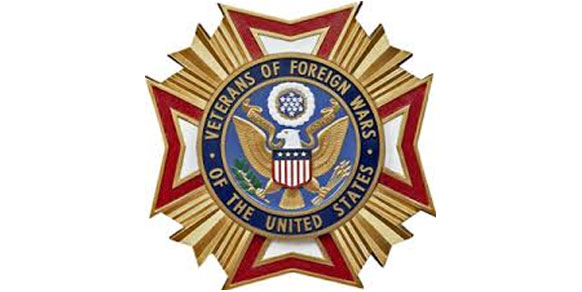
The following are the VFW posts in Fort Worth area:
VFW Post 8235
Address: 5333 White Settlement Road, Fort Worth, TX 76114 - Phone: 817.731.8231
VFW Post 8911
Address: 4937 Mansfield Hwy, Fort Worth, TX 76119 - Phone: 817.478.9909
VFW Post 10374
Address: 13825 Hwy 287 & 81, Fort Worth, TX 76179 - Phone: 817.489.7244
VFW Post 9190
Address: 5001 Old Denton Rd., Fort Worth, TX 76117 - Phone: 817.281.3903
VFW Post 2137
Address: 11875 Boyd Rd, Azle, Texas, 76020 - Phone: 817.444.2912
VFW Post 5074
705 Oak Street, PO Box 1250, Roanoke, TX 76262 - Phone: 817.491.1113
VFW Post 10429
Address: 1000 Stevens Dr, Benbrook, TX 76126 - Phone: 817.249.6470
VFW Post 5617
Address: 7501 Wyatt Dr, White Settlement, TX 76108 - Phone: (817) 246-0891
THE AMERICAN LEGION
The American Legion was chartered and incorporated by Congress in 1919 as a patriotic veterans organization devoted to mutual helpfulness. It is the nation’s largest wartime veterans service organization, committed to mentoring youth and sponsorship of wholesome programs in our communities, advocating patriotism and honor, promoting strong national security, and continued devotion to our fellow service members and veterans. There are several American Legion Posts in Fort Worth and surrounding areas and you will find the contact information below for each post.

The following are the American Legion posts in Fort Worth area:
American Legion Post 516
Address: 6801 Manhattan Blvd, Fort Worth, Texas 76120 - Phone: 817.451.7222
American Legion Post 569
Address: 400 W. Felix Street, Fort Worth, TX 76115 - Phone: 817.924.0931
American Legion Post 622
Address: 622 Shelby Road, Fort Worth, TX 76140 - Phone: 817.293.7203
American Legion Post 838
Address: 1250 Mansfield Avenue, Fort Worth, TX 76104 - Phone: 817.338.0034
American Legion 626
1125 Burton Hill Rd., Fort Worth, Texas 76114 - Phone: 817.731.3491
American Legion Post 297
Address: 8201 Old benbrook Road, Benbrook, TX 76126 - Phone: 817.249.2791
American Legion Post 5617
Address: 7501 Wyatt Drive, White Settlement, TX 76108 - Phone: 817.246.0891
8TH MARINE CORPS RECRUITING DISTRICT
The 8th Marine Corps Recruiting District is based at Naval Air Station Joint Reserve Base Fort Worth and covers the southern part of the Central states and parts of the Mountain states covering all or parts of Texas, Arkansas, Oklahoma, New Mexico, Colorado and Arizona. The 8th Marine Corps Command is headquartered right here in Fort Worth at 1513 Desert Storm Road, Fort Worth, TX 76127.
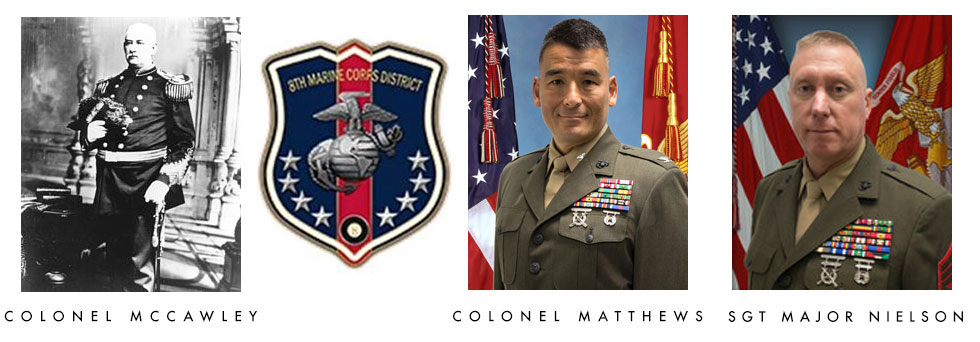
FORT WORTH POLICE DEPARTMENT
The Fort Worth Police Department was effectively begun on April 12, 1873 with a force of only four officers, but was disbanded a month later for economic reasons. The force was re-established in 1876 to cope with unruly cowboys and high levels of prostitution (Hell's Half Acre), with Jim Courtright (a former US Army scout and gunman) being instated as City Marshall with two assisting deputies. Courtright's reputation as an Army Scout and gunfighter led to an unprecedented term of nonviolence in Fort Worth. By 1887, the force had grown to six officers and a Chief of Police. Today, the Fort Worth Police Department has more than 1,500 officers with 11 stations and covers 334 square miles. Many of the Fort Worth Police Officers have extensive military backgrounds from every branch of the military.

FORT WORTH FIRE DEPARTMENT
The Fort Worth Fire Department was formed in 1872 when the Texas & Pacific Railways fueled a boom that doubled Fort Worth's population. Construction of flimsy wood buildings and small tent cities heated by fireplaces and wood stoves equaled highly destructive fires. Captain Buckley B. Paddock was a Confederate officer of the Civil War when he arrived in Fort Worth and clearly recognized that a city defenseless against fire outbreaks had no future. Captain Paddock's vision for a volunteer fire company became a reality in 1873 with their first hook-and-ladder wagon. Paddock was one of the youngest commissioned officers in the Confederate Army at 18 years of age in 1862. He would come to Fort Worth in the fall of 1872, was the editor of the Fort Worth Democrat newspaper from 1873 to 1881, was a two-time Tarrant County state representative from 1881 to 1883 and 1913 to 1915, was president of the Fort Worth and Rio Grande Railway Company from 1885 to 1889, was president of Fort Worth's Spring Palace from 1889 to 1890, four-term mayor of Fort Worth from 1892 to 1900, founder of the Fort Worth Board of Trade from 1901 to 1909, and in 1913 Tarrant County officials named a new million-dollar bridge over the Trinity River the Paddock Bridge (this is the main bridge from downtown to Panther Island). Today, the Fort Worth Fire Department has over 800 firemen with 42 stations in six Battalions responding to over 82,000 incidents every year and service all of Tarrant County. Many of the Fort Worth Fire Department members have extensive military backgrounds from every branch of the military.

FORT WORTH VA OUTPATIENT CLINIC
VA Medical Centers are a part of the Veterans Health Administration (VHA) which is the component of the United States Department of Veterans Affairs (VA) led by the Under Secretary of Veterans Affairs for Health that implements the medical assistance program of the VA through the administration and operation of numerous VA Medical Centers (VAMC), Outpatient Clinics (OPC), Community Based Outpatient Clinics (CBOC), and VA Community Living Centers (VA Nursing Home) Programs.For most Veterans in need of health care services, there only option was the Dallas VA - until the VA built a brand new Fort Worth facility at 2201 SE Loop 820, Fort Worth, TX 76119 (just east of highway 35W on Interstate 20). The Fort Worth VA Outpatient Clinic opened in November of 2010. Note: Bret Stout worked the National VA on many levels - with brand and UI strategy for the Health Informatics Initiative (T-10 to hi2), the web-based, population-driven, next generation health management platform to replace the software-based CPRS. worked with the VA's Office of Patient-Centered Care, and was elected to VA's Veteran Experience Committee.

FORT WORTH'S LOCKHEED MARTIN
Lockheed Martin is an American global aerospace, defense, security and advanced technologies company. It was formed by the merger of Lockheed Corporation with Martin Marietta in March 1995. Fort Worth's Air Force Plant 4 is a government-owned, contractor-operated aerospace facility in Fort Worth, Texas, currently owned by the U.S. Air Force and operated by Lockheed Martin Aeronautics. It is home of the F-16 and F-35 fighter aircraft. Military aircraft have been manufactured here since 1942. Plant 4 is adjacent to Naval Air Station Joint Reserve Base Fort Worth, formerly Carswell Air Force Base. Lockheed-Martin as a whole employs over 126,000 employees - and many employees are former military Veterans from all branches.

FORT WORTH'S BELL HELICOPTER
Bell Helicopter is an American aerospace manufacturer headquartered in Fort Worth, Texas. A division of Textron, Bell manufactures military rotorcraft in and around Fort Worth, as well as in Amarillo, Texas, and commercial helicopters in Mirabel, Quebec, Canada. Bell provides training and support services worldwide. In 1941, Bell hired Arthur M. Young, a talented inventor, to provide expertise for helicopter research and development. It was the foundation for what Bell hoped would be a broader economic base for his company that was not dependent on government contracts. The Bell 30 was their first full-size helicopter (first flight December 29, 1942) and the Bell 47 became the first helicopter in the world rated by a civil aviation authority, becoming a civilian and military success. Textron purchased Bell Aerospace in 1960. Bell Aerospace was composed of three divisions of Bell Aircraft Corporation, including its helicopter division, which had become its only division still producing complete aircraft. The helicopter division was renamed Bell Helicopter Company and in a few years, with the success of the UH-1 during the Vietnam War, it had established itself as the largest division of Textron. In January 1976, Textron changed the name of the company again to Bell Helicopter Textron. Bell as a whole employs over 7,000 employees - and many are former military Veterans from all branches.

There will be a lot more links added on an ongoing basis. Bookmark this page and check back often.
MAKE YOUR BUSINESS A PART OF FORT WORTH'S FUTURE AND HISTORY
Bret Stout is ready to help YOU take YOUR Fort Worth business to the next level.


BRET STOUT'S CAPABILITIES
It's much more than just a logo design or a website design – these are crucial steps in the business development cycle that make the difference in success or failure. Bret Stout has proven experience in the full business development cycle – from product ideation, brand strategy, launch strategy, Google Search, and conversion. Take a look at his full capabilities by clicking here: Bret Stout's Capabilities. The development cycle can be broken down in the following three core segments:
Brand Ideation
The first step is identifying a gap in the market and creating a solution to a problem. more>
Brand Strategy
Next step is developing strategy for the brand and understanding the target audience. more>
Brand Launch
Next major step is to launch your product to reach your specific target audience an ddemographics. more>
BRET STOUT'S CLIENTS
Of course, Bret Stout's clients included many of the biggest brands in the world – but now he focuses that experience on small to mid-sized businesses in Fort Worth.
And while his primary focus is on Fort Worth businesses (like yours), he still get's requests for work in other cities across the U.S. Below is a preview of Bret Stout's clients – and there are more than 100 client samples available in "The Work" section.

-
Testimonials

-
"Bret’s leadership and execution exceeded our expectations on work for some of the world’s most recognizable brands. We collaborated on a wide variety of projects – and through patience and extreme attention to detail, his work is refined and consistent.""
Brandon J. White, Aniden Interactive
-
"Artistry lies in the creativity, passion and focused desire and ability to bring those into a medium that can be communicated and appreciated by the masses. That, my friend is Bret Stout. You give me and your clients wings. Without you, we cannot fly."
Curtis Anderson, Director of Communications and Marketing, VA
-
"We are so pleased with the level of creativity and skill Bret Stout brings to our marketing campaigns and product launches. Bret continues to create highly creative and innovative experiences, allowing HP to appeal to consumers and businesses in unforgettable ways."
Jeff Wood, Director of Worldwide Marketing, HP
-
"Bret Stout is one of the brightest and most talented people I have ever worked with. I had to and could always rely on Bret for marketing solutions servicing my customers and fantastic artistic work. He is truly one of the nicest and most talented person I have relied on and worked with during my career."
Gene Schaeffer, Principal at Brand Solutions
-
"I immensly enjoyed working with Bret and appreciated his dedication, attention to detail, and most of all, the quality of his work! He is able to produce results in a chaotic environment and always remains calm and focused – and ALWAYS delivered-the-goods"
Mike Graziano, SVP TAISTech
-
"We hired Bret to redesign our corporate logo and website at CorporateRewards.com. He came recommended to us from the first phone call it was clear he was a creative that also truly gets the business side. He was always available and delivered on time."
Edward Brookshire, Chairman Emeritus, Workstride
-
"From my experience, there is not a better web marketing mind out there. There is no comparison. Bret is the leader and creative mind that's needed to take your business to that next level."
Todd Hollingsworth, Harley-Davidson, Caliber
Contact Bret Stout
Now that you are ready to take your Fort Worth business to the next level, it's time to contact Bret Stout.
Contact Information













